Motorola Mobility T56HX1 Portable Cellular/ PCS GSM/ EDGE Transceiver w/ BT User Manual Q GSM UG
Motorola Mobility LLC Portable Cellular/ PCS GSM/ EDGE Transceiver w/ BT Q GSM UG
Exhibit 8 Users Manual

INSTRUCTION MANUAL
A preliminary draft of the User’s Manual follows this page.
The text on the following two pages will be added to the user manual.
APPLICANT: MOTOROLA,INC.
FCC ID: IHDT56HX1
EXHIBIT 8
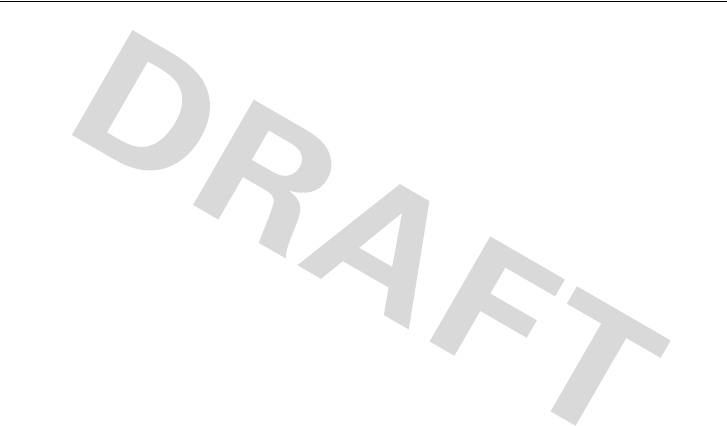
SAR Data
Specific Absorption Rate Data
SAR Da ta
This model wireless phone meets the
government’s requirements for exposure to radio
waves.
Your wireless phone is a radio transmitter and receiver. It is
designed and manufactured not to exceed limits for exposure to
radio frequency (RF) energy set by the Federal Communications
Commission (FCC) of the U.S. Government and by the Canadian
regulatory authorities. These limits are part of comprehensive
guidelines and establish permitted levels of RF energy for the
general population. The guidelines are based on standards that
were developed by independent scientific organizations through
periodic and thorough evaluation of scientific studies. The
standards include a substantial safety margin designed to assure
the safety of all persons, regardless of age or health.
The exposure standard for wireless mobile phones employs a unit
of measurement known as the Specific Absorption Rate, or SAR.
The SAR limit set by the FCC and by the Canadian regulatory
authorities is 1.6 W/kg.
1
Tests for SAR are conducted using
standard operating positions accepted by the FCC and by Industry
Canada with the phone transmitting at its highest certified power
level in all tested frequency bands. Although the SAR is
determined at the highest certified power level, the actual SAR
level of the phone while operating can be well below the
maximum value. This is because the phone is designed to operate
at multiple power levels so as to use only the power required to
reach the network. In general, the closer you are to a wireless
base station, the lower the power output.
Before a phone model is available for sale to the public in the U.S.
and Canada, it must be tested and certified to the FCC and Industry
Canada that it does not exceed the limit established by each
government for safe exposure. The tests are performed in
positions and locations (e.g., at the ear and worn on the body)
reported to the FCC and available for review by Industry Canada.
The highest SAR value for this model phone when tested for use at
the ear is 1.32 W/kg, and when worn on the body, as described in
this user guide, is 0.77 W/kg. The SAR value for this product in its
data transmission mode (body-worn use) is 0.67W/kg. (Body-worn
measurements differ among phone models, depending upon
available accessories and regulatory requirements).
2
While there may be differences between the SAR levels of various
phones and at various positions, they all meet the governmental
requirements for safe exposure. Please note that improvements to
this product model could cause differences in the SAR value for
later products; in all cases, products are designed to be within the
guidelines.

SAR Data
Additional information on Specific Absorption Rates (SAR) can be
found on the Cellular Telecommunications & Internet Association
(CTIA) Web site:
http://www.phonefacts.net
or the Canadian Wireless Telecommunications Association (CWTA)
Web site:
http://www.cwta.ca
1. In the United States and Canada, the SAR limit for mobile phones used
by the public is 1.6 watts/kg (W/kg) averaged over one gram of tissue.
The standard incorporates a substantial margin of safety to give
additional protection for the public and to account for any variations in
measurements.
2. The SAR information includes the Motorola testing protocol,
assessment procedure, and measurement uncertainty range for this
product.

1
HELLOMOTO
Thanks for purchasing the MOTO Q™ gsm wireless phone! It's a phone with a distinct
edge—personalization, music, videos, and e-mail—all in a streamlined, intelligent,
must-have device.
My Phone, My Way
– It's your phone—make it that way. Customize your home screen with
personal pictures, change wallpapers, and use your favorite song as your ringtone.
Anytime Entertainment
– Can't live without your favorite movies or music? Transfer video and
music files from your computer to your phone and instantly a media library is available anytime.
Freedom from Wires
– Your life just got a little less wired. With Bluetooth™ wireless 2.0
technology, streaming video and wireless stereo sound is now a reality.
Working Remotely
– Tired of being connected to your desk or computer? With Windows
Mobile, now you can keep on top of work e-mail and edit Microsoft Office® documents from
wherever you are in the world.
Help & QuickStart Tour
– On-phone help is available anytime. Just press
Start
>
1Help
and Quickstart
.
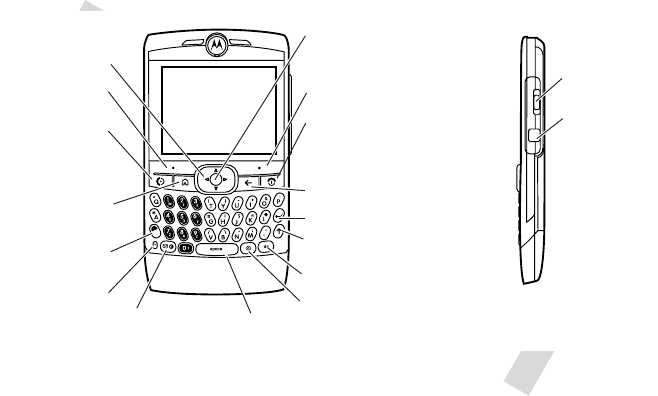
2
Here’s a quick anatomy lesson.
Left Soft Key
Navigate menus.
Center Select Key
Selects menu
items.
Camera Key
Thumb Wheel
Home Key
Right Soft Key
Undo/Back
Key
Microphone
ALT Key
Enter Key
Space Key
Caps Key
Back Key
Power/End Key
Call/Answer Key
Navigation Key
Message/
Display Off Key
Speakerphone/Voice
Recognition Key
Make & answer
calls.
Turn on & off,
hang up, exit
menus.
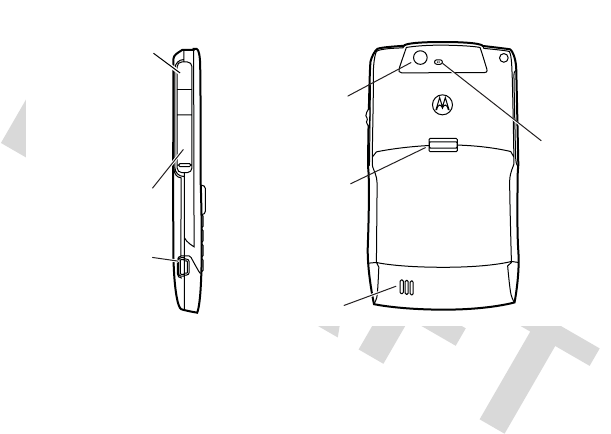
3
To avoid damaging your phone, carry it in an approved holster or case rather than a pocket, purse,
or bag.
Camera Lens
Battery Door
Release
Speakers
Camera
Flash
2.5mm Headset
Jack
Memory Card
Port
Mini USB Port
Charge and
connect phone
accessories
\
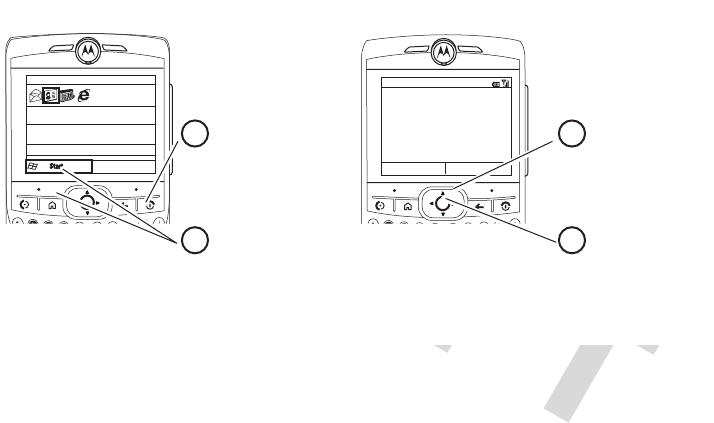
4
From the home screen, press
Start
to open the main menu.
To change your home screen shortcuts and main menu appearance, see page 36.
If you need help while using your phone press
Start
>
1Help and QuickStart
to open the in-device help.
Also see the Motorola Q Support Web site at
http://www.motorola.com/support/Q-gsm
.
The Phone Company
11:36 PM
Partner Meeting - Discuss project schedule
10:30 AM Room 100
Profile: Normal
11/10/2007
Contacts
C #QJ0
a
More Menu
g m
c
G
Start
V K
A I
Messaging Contacts ActiveSync Call History
Internet
Explorer
Tasks Windows
Media
Calendar
Home Screen Menu Screen
Press and release
the
Power Key
O
to turn on your
phone.
1
Press the
Start
key
(left soft key) to open
the main menu.
2
Press the Navigation
Key
up, down, left, or
right
(
S
) to
highlight a menu
feature.
3
Press the
Center
Select Key
s
to
select the
highlighted feature.
4
Tip:
Press the
Back Key
À
to
go back one menu.
Press the
Power Key
O
to
exit any menu or view
without saving any changes.

5
Motorola, Inc.
Consumer Advocacy Office
1307 East Algonquin Road
Schaumburg, IL 60196
www.hellomoto.com
Certain mobile phone features are dependent on the capabilities
and settings of your service provider’s network. Additionally,
certain features may not be activated by your service provider,
and/or the provider's network settings may limit the feature’s
functionality. Always contact your service provider about feature
availability and functionality. All features, functionality, and other
product specifications, as well as the information contained in this
user's guide are based upon the latest available information and
are believed to be accurate at the time of printing. Motorola
reserves the right to change or modify any information or
specifications without notice or obligation.
MOTOROLA and the Stylized M Logo are registered in the US
Patent & Trademark Office. All other product or service names are
the property of their respective owners. The Bluetooth trademarks
are owned by their proprietor and used by Motorola, Inc. under
license. Microsoft, Windows and Windows Me are registered
trademarks of Microsoft Corporation; and Windows XP is a
trademark of Microsoft Corporation.
© Motorola, Inc., 2007.
Caution:
Changes or modifications made in the radio phone, not
expressly approved by Motorola, will void the user’s authority to
operate the equipment.
Software Copyright Notice
The Motorola products described in this manual may include
copyrighted Motorola and third-party software stored in
semiconductor memories or other media. Laws in the United
States and other countries preserve for Motorola and third-party
software providers certain exclusive rights for copyrighted
software, such as the exclusive rights to distribute or reproduce
the copyrighted software. Accordingly, any copyrighted software
contained in the Motorola products may not be modified,
reverse-engineered, distributed, or reproduced in any manner to
the extent allowed by law. Furthermore, the purchase of the
Motorola products shall not be deemed to grant either directly or
by implication, estoppel, or otherwise, any license under the
copyrights, patents, or patent applications of Motorola or any
third-party software provider, except for the normal, non-exclusive,
royalty-free license to use that arises by operation of law in the
sale of a product.
Manual Number: 68XXXXX194-O

6
contents
contents
start menu . . . . . . . . . . . . 8
Safety Information . . . . . 9
FCC Notice . . . . . . . . . . . 14
use and care. . . . . . . . . . 15
EU Conformance . . . . . . 16
Recycling Information. . 17
essentials . . . . . . . . . . . . 18
about this guide. . . . . . 18
SIM card . . . . . . . . . . . 19
battery . . . . . . . . . . . . . 20
turn it on & off . . . . . . . 22
make a call. . . . . . . . . . 22
answer a call . . . . . . . . 22
store a phone number . 23
call a stored number . . 23
your phone number . . . 24
tips & tricks . . . . . . . . . . 25
basics . . . . . . . . . . . . . . . 26
display . . . . . . . . . . . . . 26
text entry . . . . . . . . . . . 28
volume. . . . . . . . . . . . . 30
handsfree speaker. . . . 30
lock & unlock phone . . 31
storage card. . . . . . . . . 32
flight mode . . . . . . . . . 33
file manager. . . . . . . . . 33
task manager. . . . . . . . 33
customize. . . . . . . . . . . . 35
profiles. . . . . . . . . . . . . 35
home screen . . . . . . . . 36
home screen shortcuts 38
start menu. . . . . . . . . . 38
time & date . . . . . . . . . 39
backlight . . . . . . . . . . . 39
answer options . . . . . . 39
third-party applications 40
calls. . . . . . . . . . . . . . . . . 41
turn off a call alert . . . . 41
recent calls . . . . . . . . . 41
redial . . . . . . . . . . . . . . 42
view missed calls . . . . 42
caller ID . . . . . . . . . . . . 43
emergency calls . . . . . 43
international calls . . . . . 43
speed dial . . . . . . . . . . 44
voicemail . . . . . . . . . . . 45
three-way calling . . . . . 46

contents
7
messages . . . . . . . . . . . 47
set up personal e-mail 47
set up MSN or Hotmail
e-mail . . . . . . . . . . . . . 48
set up corporate e-mail 48
synchronize. . . . . . . . . 49
receive & read
messages. . . . . . . . . . 53
send a message . . . . . 54
global address lookup. 55
messaging shortcuts . 56
messaging quick
reference . . . . . . . . . . 57
connections . . . . . . . . . 63
Bluetooth™ wireless . 63
Internet Sharing . . . . . 67
Web browser . . . . . . . 72
entertainment. . . . . . . . 73
take & send a photo . . 73
record & play video
clips . . . . . . . . . . . . . . 75
download & copy
media files . . . . . . . . . 78
media player . . . . . . . . 79
other features . . . . . . . . 81
advanced calling . . . . . 81
contacts . . . . . . . . . . . 82
personalizing. . . . . . . . 84
call times . . . . . . . . . . 86
handsfree . . . . . . . . . . 87
network connections . 87
calendar . . . . . . . . . . . 88
memo pad . . . . . . . . . 89
calculator . . . . . . . . . . 90
converter . . . . . . . . . . 90
security. . . . . . . . . . . . 90
phone information . . . 90
fun & games. . . . . . . . 91
service & repair. . . . . . . 93
SAR Data. . . . . . . . . . . . 94
Warranty . . . . . . . . . . . . 95
WHO Information . . . . . 99
Microsoft License . . . . 100
index . . . . . . . . . . . . . . 105

8
start menu
start menu
main menu
To open the menu from the home screen,
press
Start
(left soft key).
g
Internet Explorer
$
Ta s k s
c
Windows Media
%
Calendar
&
Messaging
• Text Messages
•E-mail
• MMS
(
Contacts
A
ActiveSync
This is the standard menu layout.
Your
phone’s menu may be different.
To
change your home screen shortcuts and
main menu appearance, see page 35.
To select menu items, press your
navigation key up, down, left, or right.
Å
Call History
)
Settings
• Phone
• Sounds
• Profiles
• Home Screen
•Clock & Alarm
• Connections
• Security
• Remove Programs
• Power Management
• Accessibility
• Regional Settings
• Owner Information
• About
• Error Reporting
• TTY Settings
• Text Input Settings
• Unread Message Alert
• Phone Information
2
Games
Ä
Voi c e Notes
Ã
Pictures & Videos
-
Accessories
Â
Internet Sharing
/
File Manager
1
Help and QuickStart
Á
InstantMessenger
[
Media Center
W
Messenger
3
Speed Dial
\
Voice Recognition
7
Windows Live
8
Windows Update
]
Bluetooth
>
Documents To Go
=
Personalize My Q
9
System Tools

Safety Information
9
Safety and General Information
Safet y Informa tion
This section contains important information on the safe and
efficient operation of your mobile device. Read this
information before using your mobile device.
*
Exposure to Radio Frequency (RF)
Energy
Your mobile device contains a transmitter and receiver. When it is
ON, it receives and transmits RF energy. When you communicate
with your mobile device, the system handling your call controls the
power level at which your mobile device transmits.
Your Motorola mobile device is designed to comply with local
regulatory requirements in your country concerning exposure of
human beings to RF energy.
Operational Precautions
For optimal mobile device performance and to be sure that human
exposure to RF energy does not exceed the guidelines set forth in
the relevant standards, always follow these instructions and
precautions.
External Antenna Care
If your mobile device has an external antenna, use only a
Motorola-supplied or approved replacement antenna. Use of
unauthorized antennas, modifications, or attachments could
damage the mobile device and/or may result in your device not
complying with local regulatory requirements in your country.
DO NOT hold the external antenna when the mobile device is IN
USE. Holding the external antenna affects call quality and may
cause the mobile device to operate at a higher power level than
needed.
Product Operation
When placing or receiving a phone call, hold your mobile device
just like you would a landline phone.
If you wear the mobile device on your body, always place the
mobile device in a Motorola-supplied or approved clip, holder,
holster, case, or body harness. If you do not use a body-worn
accessory supplied or approved by Motorola, keep the mobile
device and its antenna at least 2.5 centimeters (1 inch) from your
body when transmitting.
* The information provided in this document supersedes the general
safety information in user’s guides published prior to May 1, 2006.

10
Safety Information
When using any data feature of the mobile device, with or without
an accessory cable, position the mobile device and its antenna at
least 2.5 centimeters (1 inch) from your body.
Using accessories not supplied or approved by Motorola may
cause your mobile device to exceed RF energy exposure
guidelines. For a list of Motorola-supplied or approved
accessories, visit our web site at:
www.motorola.com
.
RF Energy Interference/Compatibility
Nearly every electronic device is subject to RF energy interference
from external sources if inadequately shielded, designed, or
otherwise configured for RF energy compatibility. In some
circumstances your mobile device may cause interference with
other devices.
Follow Instructions to Avoid Interference
Problems
Turn off your mobile device in any location where posted notices
instruct you to do so. These locations include hospitals or health
care facilities that may be using equipment that is sensitive to
external RF energy.
In an aircraft, turn off your mobile device whenever instructed to
do so by airline staff. If your mobile device offers an airplane mode
or similar feature, consult airline staff about using it in flight.
Pacemakers
If you have a pacemaker, consult your physician before using this
device.
Persons with pacemakers should observe the following
precautions:
•
ALWAYS keep the mobile device more than
20 centimeters (8 inches) from your pacemaker when the
mobile device is turned ON.
•
DO NOT carry the mobile device in the breast pocket.
•
Use the ear opposite the pacemaker to minimize the
potential for interference.
•
Turn OFF the mobile device immediately if you have any
reason to suspect that interference is taking place.
Hearing Aids
Some mobile devices may interfere with some hearing aids. In the
event of such interference, you may want to consult your hearing
aid manufacturer or physician to discuss alternatives.
Other Medical Devices
If you use any other personal medical device, consult your
physician or the manufacturer of your device to determine if it is
adequately shielded from RF energy.
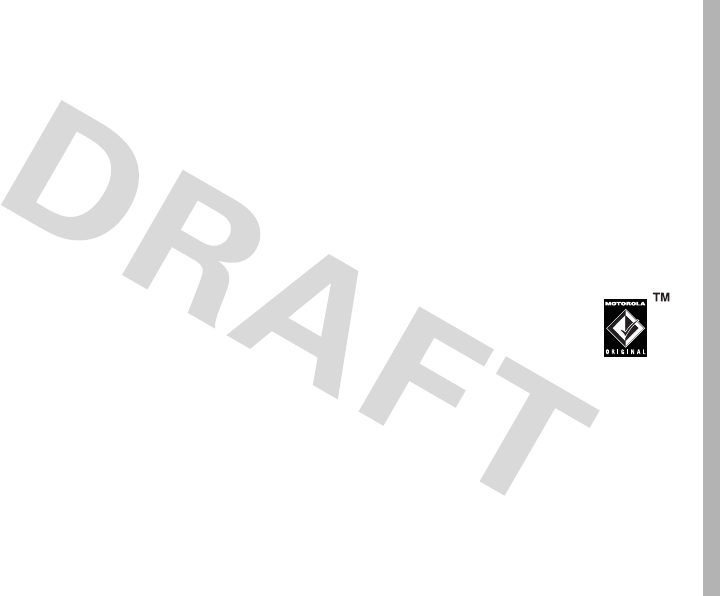
Safety Information
11
Driving Precautions
Check the laws and regulations on the use of mobile devices in the
area where you drive. Always obey them.
When using your mobile device while driving, please:
•
Give full attention to driving and to the road. Using a
mobile device may be distracting. Discontinue a call if you
can’t concentrate on driving.
•
Use handsfree operation, if available.
•
Pull off the road and park before making or answering a
call if driving conditions so require.
Responsible driving practices can be found in the “Smart Practices
While Driving” section at the end of this guide and/or at the
Motorola web site:
www.motorola.com/callsmart
.
Operational Warnings
Obey all posted signs when using mobile devices in public areas,
such as health care facilities or blasting areas.
Automobile Air Bags
Do not place a mobile device in the air bag deployment area.
Potentially Explosive Atmospheres
Areas with potentially explosive atmospheres are often but not
always posted, and can include fueling areas such as below decks
on boats, fuel or chemical transfer or storage facilities, or areas
where the air contains chemicals or particles, such as grain, dust,
or metal powders.
When you are in such an area, turn off your mobile device, and do
not remove, install, or charge batteries. In such areas, sparks can
occur and cause an explosion or fire.
Damaged Products
If your mobile device or battery has been submerged in water,
punctured, or subjected to a severe fall, do not use it until you take
it to a Motorola Authorized Service Center. Do not attempt to dry it
with an external heat source, such as a microwave oven.
Batteries and Chargers
If jewelry, keys, beaded chains, or other conductive
materials touch exposed battery terminals, this
could complete an electrical circuit (short circuit),
become very hot, and could cause damage or
injury. Be careful when handling a charged battery,
particularly when placing it inside a pocket, purse, or other
container with metal objects.
Use only Motorola Original
batteries and chargers.
Caution:
To avoid risk of personal injury, do not dispose of your
battery in a fire.
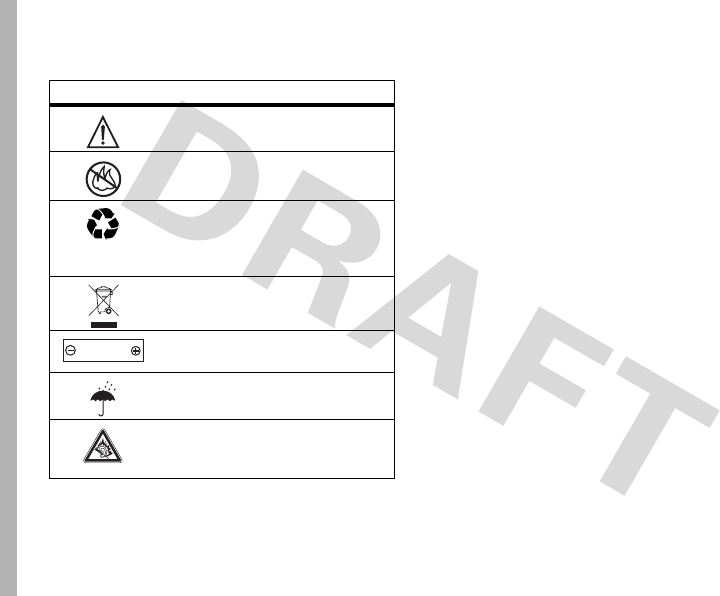
12
Safety Information
Your battery, charger, or mobile device may contain symbols,
defined as follows:
Choking Hazards
Your mobile device or its accessories may include detachable
parts, which may present a choking hazard to small children. Keep
your mobile device and its accessories away from small children.
Glass Parts
Some parts of your mobile device may be made of glass. This glass
could break if the product is dropped on a hard surface or receives
a substantial impact. If glass breaks, do not touch or attempt to
remove. Stop using your mobile device until the glass is replaced
by a qualified service center.
Seizures/Blackouts
Some people may be susceptible to epileptic seizures or blackouts
when exposed to flashing lights, such as when playing video
games. These may occur even if a person has never had a previous
seizure or blackout.
If you have experienced seizures or blackouts, or if you have a
family history of such occurrences, please consult with your
physician before playing video games or enabling a flashing-lights
feature (if available) on your mobile device.
Discontinue use and consult a physician if any of the following
symptoms occur: convulsion, eye or muscle twitching, loss of
awareness, involuntary movements, or disorientation. It is always
a good idea to hold the screen away from your eyes, leave the
Symbol Definition
Important safety information follows.
Do not dispose of your battery or mobile
device in a fire.
Your battery or mobile device may require
recycling in accordance with local laws.
Contact your local regulatory authorities
for more information.
Do not throw your battery or mobile device
in the trash.
Your mobile device contains an internal
lithium ion battery.
Do not let your battery, charger, or mobile
device get wet.
Listening at full volume to music or voice
through a headset may damage your
hearing.
032374o
032376o
032375o
032378o
Li Ion BATT
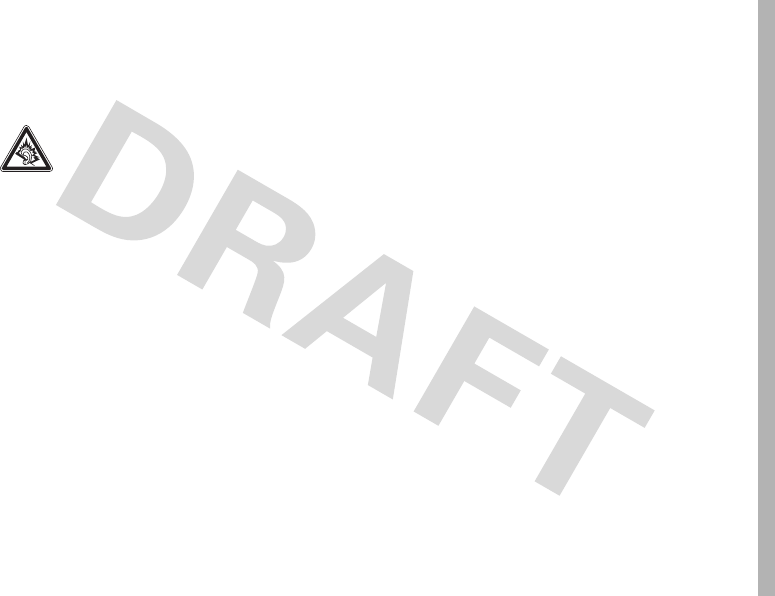
Safety Information
13
lights on in the room, take a 15-minute break every hour, and stop
use if you are very tired.
Caution About High Volume Usage
Listening at full volume to music or voice through a
headset may damage your hearing.
Repetitive Motion
When you repetitively perform actions such as pressing keys or
entering finger-written characters, you may experience occasional
discomfort in your hands, arms, shoulders, neck, or other parts of
your body. If you continue to have discomfort during or after such
use, stop use and see a physician.

14
FCC Notice
FCC Notice to Users
FCC Notice
The following statement applies to all products that have
received FCC approval. Applicable products bear the FCC
logo, and/or an FCC ID in the format FCC-ID:xxxxxx on the
product label.
Motorola has not approved any changes or modifications to this
device by the user. Any changes or modifications could void the
user’s authority to operate the equipment. See 47 CFR Sec. 15.21.
This device complies with part 15 of the FCC Rules. Operation is
subject to the following two conditions: (1) This device may not
cause harmful interference, and (2) this device must accept any
interference received, including interference that may cause
undesired operation. See 47 CFR Sec. 15.19(3).
If your mobile device or accessory has a USB connector, or is
otherwise considered a computer peripheral device whereby it can
be connected to a computer for purposes of transferring data, then
it is considered a Class B device and the following statement
applies:
This equipment has been tested and found to comply with the
limits for a Class B digital device, pursuant to part 15 of the FCC
Rules. These limits are designed to provide reasonable protection
against harmful interference in a residential installation. This
equipment generates, uses and can radiate radio frequency energy
and, if not installed and used in accordance with the instructions,
may cause harmful interference to radio communications.
However, there is no guarantee that interference will not occur in a
particular installation. If this equipment does cause harmful
interference to radio or television reception, which can be
determined by turning the equipment off and on, the user is
encouraged to try to correct the interference by one or more of the
following measures:
•
Reorient or relocate the receiving antenna.
•
Increase the separation between the equipment and the
receiver.
•
Connect the equipment to an outlet on a circuit different
from that to which the receiver is connected.
•
Consult the dealer or an experienced radio/TV technician
for help.
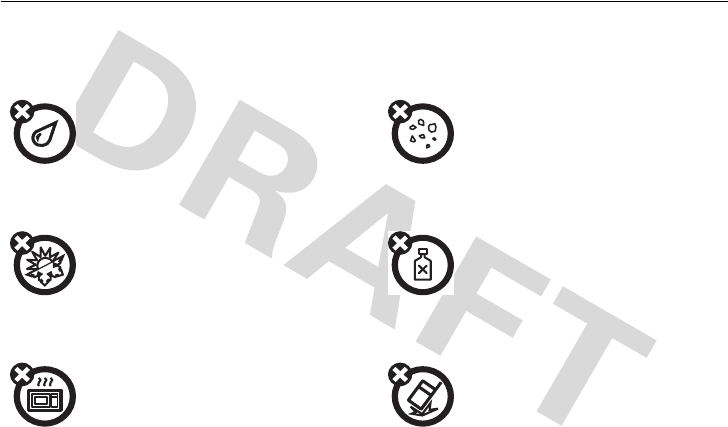
use and care
15
Use and Care
use and care
To care for your Motorola phone, please keep it away from:
liquids of any kind dust and dirt
Don’t expose your phone to water, rain,
extreme humidity, sweat, or other moisture.
Don’t expose your phone to dust, dirt, sand,
food, or other inappropriate materials.
extreme heat or cold cleaning solutions
Avoid temperatures below -10°C/14°F or
above 45°C/113°F.
To clean your phone, use only a dry soft cloth.
Don’t use alcohol or other cleaning solutions.
microwaves the ground
Don’t try to dry your phone in a microwave
oven.
Don’t drop your phone.
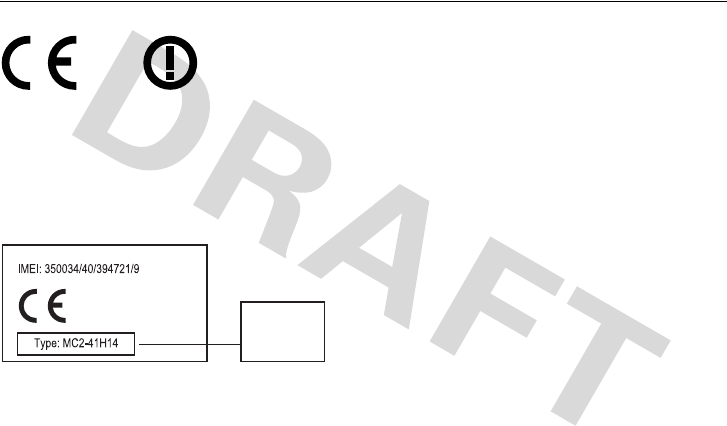
16
EU Conformance
European Union Directives Conformance Statement
EU Conformance
Hereby, Motorola declares that this product is in compliance with:
•
The essential requirements and other relevant provisions
of Directive 1999/5/EC
•
All other relevant EU Directives
The above gives an example of a typical Product Approval Number.
You can view your product’s Declaration of Conformity (DoC) to
Directive 1999/5/EC (to R&TTE Directive) at
www.motorola.com/rtte
. To find your DoC, enter the
product Approval Number from your product’s label in the “Search”
bar on the Web site.
[France Only]
0168
Product
Approval
Number

Recycling Information
17
Recycling Information
Caring for the Environment by Recycling
This symbol on a Motorola product means the product
should not be disposed of with household waste.
Disposal of your Mobile Telephone and Accessories
Please do not dispose of mobile telephones or electrical
accessories, such as chargers or headsets, with your household
waste. In some countries or regions, collection systems have been
set up to handle waste electrical and electronic items. Please
contact your regional authorities for more details. If no suitable
scheme exists, you may return unwanted mobile telephones and
electrical accessories to any Motorola Approved Service Centre in
your region.
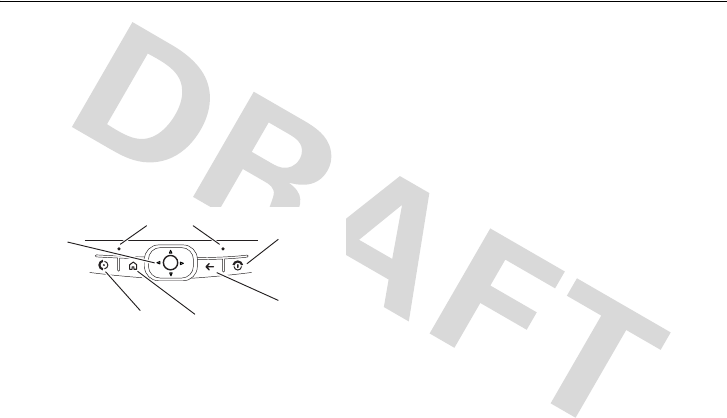
18
essentials
essentials
about this guide
Press the left and right soft keys to open
menus and select options. Use the
navigation key
S
to scroll to items, and
press the center key
s
to select them.
This guide shows how to locate a menu
feature as follows:
Find it:
Start
>
Call History
> (received call)
This means that, from the home screen:
1
Press the left soft key to open the
Start
menu.
2
Press the navigation key
S
to scroll to
Call History
. Press the center select key
s
to select
Call History
.
3
Press the navigation key to scroll to a
received call. Press the center select key
to select the call.
Tip:
You can use the thumb wheel to
scroll up and down, and press the
thumb wheel to select items (see page 2
for thumb wheel location).
Navigation
and Center
Select Key
Left Soft Key Right Soft Key
Undo/Back
Key
Home Key
Power Key
Call/Answer Key
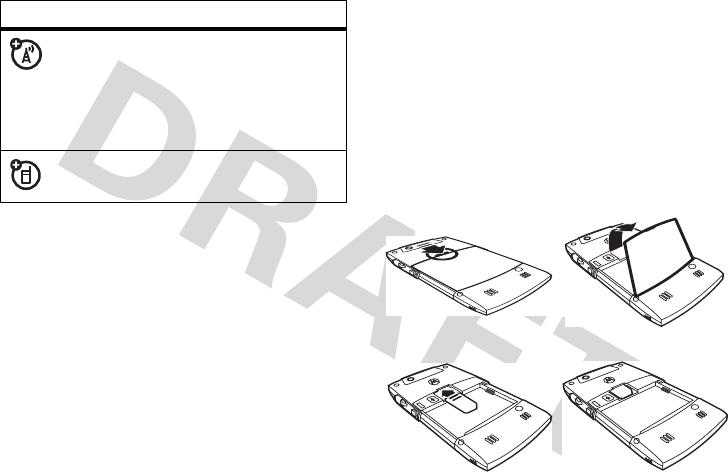
19
essentials
SIM card
Caution:
Don’t bend or scratch your SIM card.
Keep it away from static electricity, water,
and dirt.
Yo u r Subscriber Identity Module (SIM) card
contains personal information like your phone
number and contacts entries. It can also
contain your voicemail, text message, and
Internet access settings. If you put your SIM
card in another phone, that phone uses your
phone number.
To insert and use a
storage card
, see
page 32.
Turn off your phone and remove your
battery before you install or remove a
SIM card.
symbols
This means a feature is
network/subscription dependent
and may not be available in all areas.
Contact your service provider for
more information.
This means a feature requires an
optional accessory.
12
34
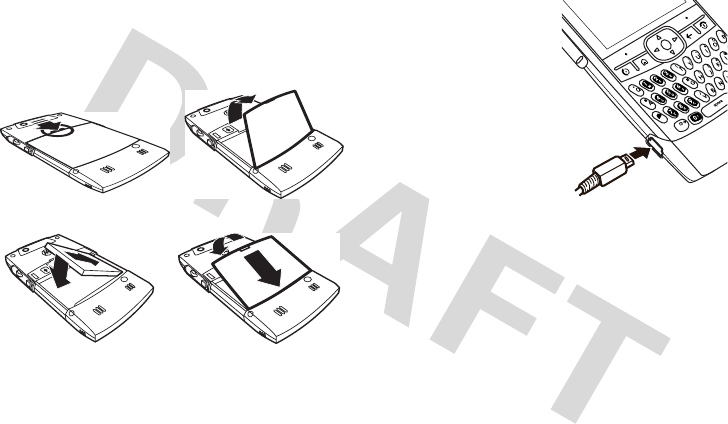
20
essentials
battery
battery installation
battery charging
New batteries are not
fully charged. Plug the
battery charger into
your phone and an
electrical outlet. Your
phone might take
several seconds to
start charging the
battery. When
finished, your phone
displays a full battery icon
J
.
Tip:
Relax, you can’t overcharge your battery.
It will perform best after you fully charge and
discharge it a few times.
Unless your battery is completely drained, you
can also charge your battery by using a
USB cable
plugged into a computer. Use a
wall charger or car charger for completely
12
34
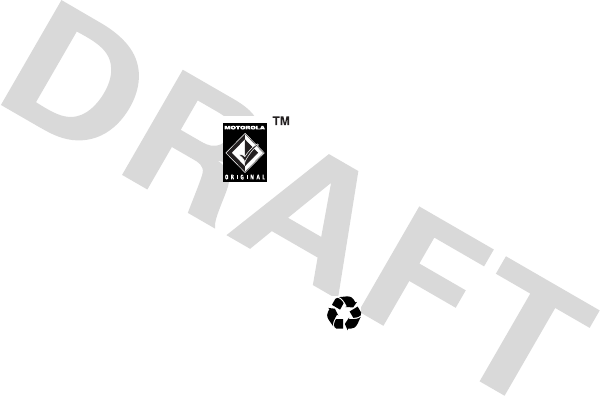
21
essentials
drained batteries. Some USB ports charge
faster than others.
battery tips
Battery life depends on the network, signal
strength, temperature, features, and
accessories you use.
•
Always use Motorola
Original batteries and
chargers. The warranty does
not cover damage caused by
non-Motorola batteries
and/or chargers.
•
New batteries or batteries stored for a
long time may take more time
to charge.
•
When charging your battery, keep it
near room temperature.
When storing your battery, keep it
uncharged in a cool, dark, dry place.
•
Never expose batteries to
temperatures below -10°C (14°F) or
above 45°C (113°F). Always take your
phone with you when you leave
your vehicle.
•
It is normal for batteries to gradually
wear down and require longer charging
times. If you notice a change in your
battery life, it is probably time to buy a
new battery.
Contact your local recycling center for
proper battery disposal.
Warning:
Never dispose of batteries in a fire
because they may explode.
032375o
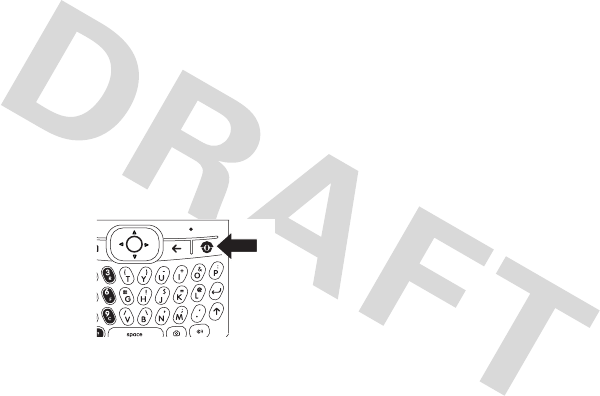
22
essentials
Before using your phone, read the battery
safety information in the “Safety and General
Information” section included in this guide.
To save battery life:
•
Adjust the backlight to turn off more
quickly (see page 38).
•
Turn off Bluetooth power when you are
not using it (see page 62).
turn it on & off
To turn on your
phone
, press and
release
O
. If
prompted, enter
your four-digit
unlock code.
Tip:
If your phone does not turn on, take your
battery out, put it back in, and try again.
To turn off your phone
, press and hold
O
for three seconds, then
release
it.
make a call
From the home screen, enter a phone
number and press
N
to make a call.
To voice dial, see page 80.
answer a call
When your phone rings and/or vibrates, press
N
to answer. To “hang up,” press
O
.
•
If you are busy when a call comes in,
press
Ignore
to send the call directly to
voicemail.
•
To put a call on hold, press
N
. To
return to the call, press
N
again.

23
essentials
•
If you are on a call and another call
comes in, you can press
Ignore
to send
the new call directly to voicemail or
press
N
to answer it and put the
current call on hold (press
N
to switch
between the two calls).
store a phone number
Find it:
Start
>
Contacts
and press
New
1
Choose whether to store the contact on
your phone or your SIM card. Contacts on
the SIM card can include only a name
and number.
2
Enter information for the contact.
Tip:
While you are entering the number,
you can tell your phone to pause and then
dial more digits (for example, for a
voicemail password or PIN). Press
Menu
>
Insert Pause
to insert a 2-second pause
(shows as a
p
) or press
Menu
>
Insert Wait
to
tell your phone to prompt you before
dialing the remaining digits (shows as
a
w
).
Tip:
If you get a call or message from
someone who isn't in your list of contacts,
you can add them to your contacts from
Call History
, or from the message by pressing
Menu
>
Save to Contacts
.
call a stored number
Find it:
Start
>
Contacts
1
Scroll to the number.
2
Press
N
.
Your phone calls the contact’s default number.

24
essentials
Tip:
If you stored more than one number for a
contact, select the contact to see the other
numbers. To dial a number, scroll to it and
press
N
.
your phone number
To view your phone number, press
Start
>
Settings
>
Phone
>
Call Options
.

25
tips & tricks
tips & tricks
From the home screen
(page 26), you can
use the following shortcuts:
To... Do this...
view quick
options
Press and hold
X
to open a
list of quick options.
use most
recently
used
feature
Icons for your most recently
used features appear across
the top of the home screen.
Use the navigation keys to
select one.
lock phone
Be sure you know your
password, then press
X
and the space bar.
access
messaging
Quickly access messaging
features by pressing . In a
message, press and hold
0
to see a list of messaging
shortcuts.
change
flight mode
Press and hold
X
to open
the quick list, select the
Wireless Manager, and
select flight mode.
use memo
pad
Jot down and retrieve quick
notes on the memo pad:
Start
>
Accessories
>
Memo pad
.
take
pictures
Quickly start the camera by
pressing
e
.
To... Do this...
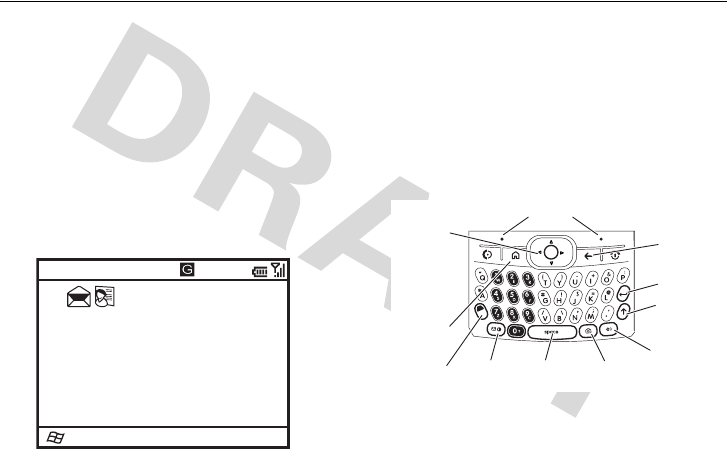
26
basics
basics
See page 2 for a basic phone diagram.
display
The home screen appears when you turn on
the phone. To dial a number from the home
screen, press number keys and
N
.
Note:
Your home screen may look different
from this example.
Soft key labels show the current soft key
functions. For soft key locations, see page 2.
Press the navigation key
S
up, down, left, or
right to scroll to basic menu items or text in
the home screen. Press
X
to return to the
home screen.
Start
Home Service
Text Messages (0)
No upcoming appointments.
Profile: Normal
12:00 PM
12/31/07
Contacts
)
Navigation
and Center
Select Key
Left Soft Key Right Soft Key
ALT Key
Caps Key
Enter Key
Home Key
Space
Key
Messages/
Display Off Key Camera
Key
Voice
Recognition
Key
Undo/Back
Key
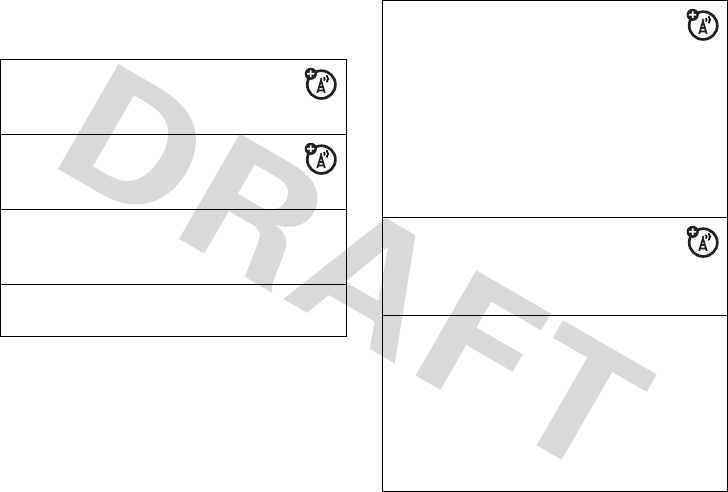
27
basics
Status indicators can appear at the top of the
home screen:
w
Voicemail Indicator –
Shows when you have new
voicemail.
C
Message Indicator –
Shows
when you receive new e-mail
or text messages.
E
Bluetooth Indicator –
Shows
when you have a Bluetooth
wireless connection.
D
Call Forward Indicator –
Shows
when call forwarding is on.
G
f
)
\
Roam Indicator –
Shows
G
when your phone is seeking
or using a network outside
your home network. Other
indicators can include:
•
f
home GPRS
•
)
roaming GPRS
•
\
EDGE
H
I
Active Line Indicator –
For
multi-line SIM cards, this
indicates whether line
H
or
I
is active.
Q
<
%
Profile Indicator –
Shows when
your ring style is set to
Silent
(
Q
) or
Vibrate
(
<
). No indicator appears
when the ring style profile is
Normal
,
Outdoor
, or
Automatic
.
Note:
A
%
appears when the
speakerphone is on (see page 30).
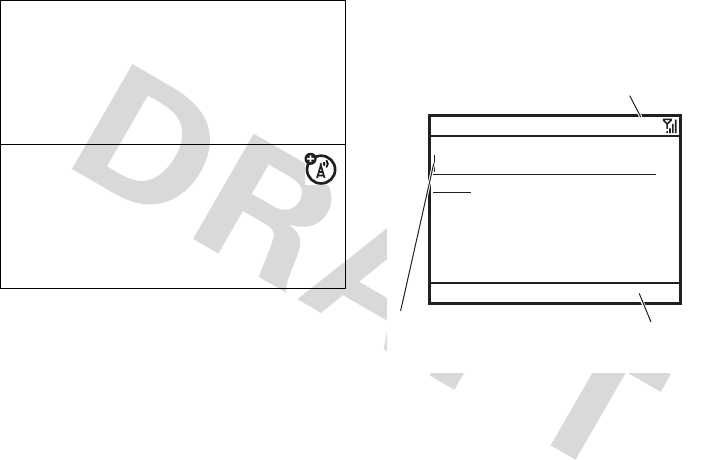
28
basics
text entry
You can enter text and numbers using the
keypad. When you select a field that requires
text or numbers, the phone automatically
selects the appropriate entry mode. An
indicator at the top right of the display shows
the entry mode you are currently using.
J
Battery Level Indicator –
Vertical
bars show the battery charge level.
Recharge the battery when your
phone shows one or two bars.
Arrow indicators above the battery
indicator signify data transfer.
0
Signal Strength Indicator –
Vertical bars show the
strength of the network
connection. You can’t make or
receive calls when no vertical
bars appear.
Press
Menu
to
open the sub-menu.
Flashing cursor
indicates insertion point.
Press the ALT key to
switch entry modes.
>
Send
Text Messages
To:
0/160
Menu
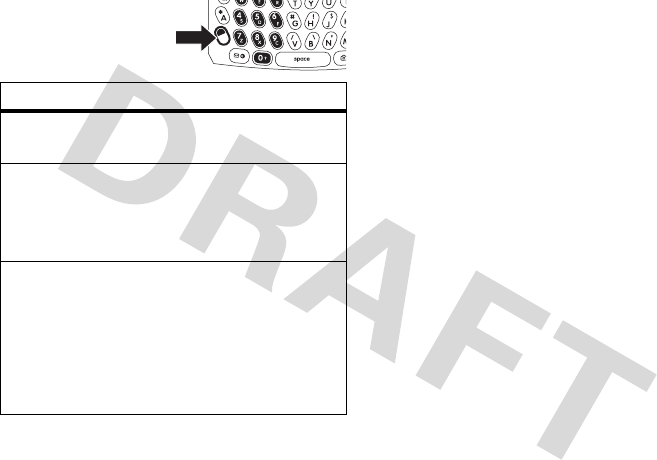
29
basics
Press
=
in a text
entry view to select
an entry mode:
•
To
delete
one character, press
w
.
Hold
w
to keep deleting.
•
To start a new line, press
j
.
•
Press
k
to switch to all capital letters
(
[
), no capitals (
>
), or next letter
capital (
]
).
•
To enter the number or character above
the letter on each key, press the
Alt key
=
. Press
=
twice to lock it. To
enter other special characters and
foreign alphabet characters, press the
Alt key
=
followed by the Shift key
k
.
text prediction
As you enter letters, your phone might try to
predict
the word. For instance, it might
predict “program” when you enter “prog”.
To accept the prediction, press
S
right. To
see alternate predictions, hold
S
down. To
enter a space after your characters (such as
“prog”), press the space bar. To turn off text
entry modes
>
Enters the large character on each
key (such as
Q
).
{
Enters the small symbol or number
on the next key pressed (such as
!
),
then returns to the previous text
entry mode.
}
Enters the small symbols and
numbers on the keys until you
press
=
again.
Your phone automatically chooses
Ä
for entries that only allow
numbers, like phone numbers.
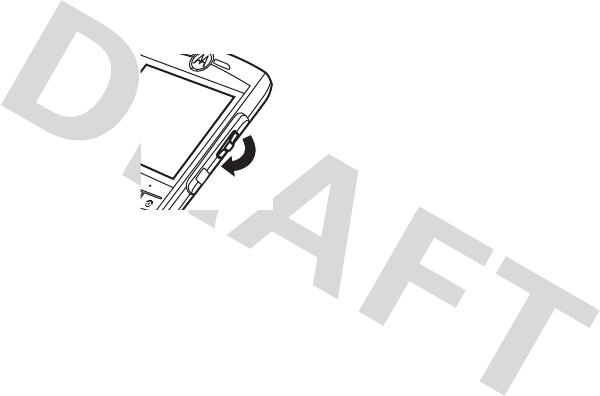
30
basics
prediction, press
Start
>
Settings
>
Text Input Settings
and uncheck
Suggest words when typing
.
volume
To set the
earpiece
volume, press and hold
the thumb wheel. Your
phone uses this same
volume setting for its
speaker
or a
headset
.
•
Want to change
profiles? On the home screen, scroll to
and select
Profile
. Choose from
Normal
,
Silent
, and others.
•
Want to turn off a sound? Press
Start
>
Settings
>
Sounds
and select
None
.
Tip:
You can eliminate the ringer volume
instantly when an incoming call comes
in—just use the thumb wheel to turn the
ringer off.
handsfree speaker
Note:
The use of wireless phones while
driving may cause distraction. Discontinue a
call if you can’t concentrate on driving.
Additionally, the use of wireless devices and
their accessories may be prohibited or
restricted in certain areas. Always obey the
laws and regulations on the use of
these products.
You can use your phone’s handsfree speaker
on calls without holding the phone to your ear.
Note:
The handsfree speaker won’t work
when your phone is connected to a car kit
or headset.

31
basics
lock & unlock phone
You can manually lock your phone to prevent
accidental key presses.
To
lock your phone
, press
X
and then the
space bar. Your left soft key becomes
Unlock
.
To
unlock your phone
, press
Unlock
and
then *. Then, enter your password and
press
Unlock
again. Your phone uses
*
if you
have not set a password.
To
keep others from using your phone
,
change your password:
Find it:
From the home screen, press
Start
>
Settings
>
Security
>
Device Lock
1
Select
Prompt if device unused for
, and select the
time you want the phone to be inactive
before automatically locking.
2
Choose either a simple (4-digit number) or
strong password (a mixture of at least 7
uppercase and lowercase letters,
numbers, and punctuation).
3
Enter and confirm your password.
4
Press
Done
.
To unlock the phone, press
Unlock
. At the
prompt, enter your password and press
Done
.
Caution: Make your password something
you will remember!
Without your password,
you can reset your phone, but you will lose
your personalized settings and all content
stored in phone memory. To perform a hard
reset, hold down the center key
s
for
5 seconds while turning the phone on.
Note:
You can make emergency calls on a
locked phone (see page 42). A locked phone
still rings or vibrates for incoming calls or
messages,
but you do not need to unlock it
to answer
.
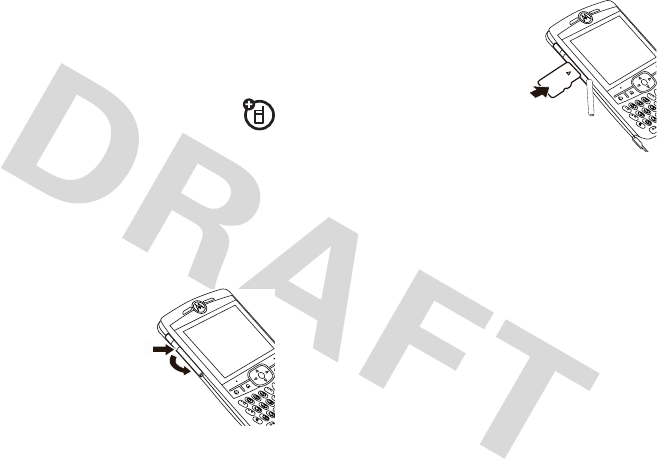
32
basics
storage card
Note:
A storage card is not included with your
phone. It is sold separately.
You can use a removable miniSD
storage card with your phone to store
content music, pictures, videos, applications,
and files.
Caution:
Do not remove your storage card
while your phone is using or writing files on it.
To insert a miniSD storage card:
1
Open the card slot
cover by putting your
fingernail on the ridge
of cover and gently
lifting it.
2
Insert the storage card
into the slot with the
metal contacts facing
down. The card clicks
into place.
3
Replace the storage
card cover and press
to close it.
Caution:
Don’t bend or scratch your storage
card. Keep it away from static electricity,
water, and dirt.
Note:
Your phone supports miniSD cards up
to 1 GB. To save storage space on your
phone, move media files (pictures, videos,
music) to a storage card as often as possible.
\
\

33
basics
flight mode
You can turn off your phone’s network and
Bluetooth services to safely access your
address book, games, camera, and music in
areas where cellular network access is
prohibited (such as during flights and
in hospitals).
Press and hold
X
until the
Quick List
appears.
Select
Wireless Manager
. Scroll to
All
and press
the center key
s
.
file manager
You can use File Manager to sort, view, copy,
and move files on your phone or storage card.
You can use the file manager for files, such as
text, pictures, music, and video files.
Find it:
Start
>
File Manager
task manager
Want to see what programs are running on
your phone? Use the Task Manager to see or
stop a program.
Find it:
Start
>
System Tools
>
Task Manager
Tip:
Need to stop running program? In
Task
Manager
, select the program and press
Menu
>
Kill
.
Note:
To completely remove a program from
your phone, from the home screen, press
Start
>
Settings
>
Remove Programs
. Select the
program and press
Menu
>
Remove
.

34
customize
customize
profiles
Each profile uses a different set of sounds,
ring styles, earpiece volume settings, or
vibrations for incoming calls and other events.
For example, the
Outdoor
profile volume is
much louder than the
Normal
profile.
Here are the profiles:
To choose your profile:
Find it:
On the home screen, scroll and select
Profile:
> profile style name
Indicators can appear at the top of your home
screen for the
Silent
(
Q
) and
Vibrate
(
<
)
profiles. A
%
means the speakerphone is on
(see page 30).
Note:
The
Automatic
profile is the same as
Normal
, except that it automatically switches to
Vibrate
during any event stored in
your Calendar.
change ring tones in profile
You can change the ring tones for incoming
calls and other events. Your changes are
saved in the current ring style profile.
Find it:
Start
>
Settings
>
Sounds
Note:
Changes made to the alert settings have no effect when using the
Silent
profile.
Normal Vibrate Automatic
Silent Outdoor
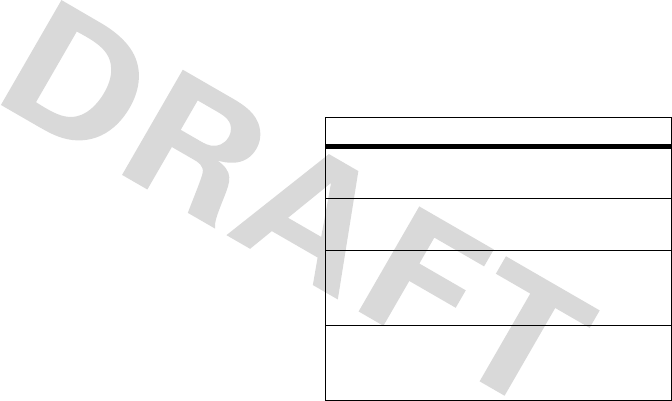
35
customize
1
Scroll and highlight the sound you want to
change, then press the navigation key
S
right or left to change it.
2
Press the
Done
key to save the
sound setting.
Note:
Downloading a sound file for a ring
tone does not automatically save it in the
Sounds location. To move your sound file,
press
Start
>
File Manager
>
My Documents
.
Highlight the sound file you want to copy
to the Sound location, press
Menu
>
File
>
Copy to
and select
Application Data
>
Sounds
. If
the sound file is not located in the My
Documents folder, go to the folder where
the sound file is stored and copy it to the
Sounds folder.
Tip:
You can also change your sounds by
selecting
Start
>
PersonalizeMyQ
>
Sounds Settings
.
home screen
Set a photo, picture, or animation as a
wallpaper (background) image or change your
layout and color scheme on your
home screen.
Find it:
Start
>
PersonalizeMyQ
>
Homescreen Settings
options
Home Screen
Layout
Select a layout for the
home screen.
Color Scheme
Select a color scheme for
the display.
Background
Image
Select a picture for your
wallpaper image, or
None
for
no wallpaper.
Time out
Select the time interval
before the display will go
inactive or
Never
.

36
customize
change background image
Want to copy an image from your computer to
your phone to use as a background image?
Note:
You must have installed
Microsoft® ActiveSync 4.5 on your computer,
as described on page 49.
1
Connect the phone to your computer.
2
On your computer, copy the image file
you want. The file format must be GIF,
JPG, or BMP.
3
In ActiveSync on your computer, select
Explore, and double-click My Windows®
Mobile device.
4
Double-click Application Data, double-click
Home, and paste the image into
that folder.
Note:
Downloading a picture file to use as
wallpaper does not automatically save it in
the
My Pictures
folder. To move your picture
file, press
Start
>
File Manager
>
My Documents
.
Highlight the picture file you want to copy
to the My Pictures location, press
Menu
>
File
>
Copy to
and select
My Documents
>
My Pictures
. If the picture file is not
located in the
My Documents
folder, go to the
folder where the sound file is stored and
copy it to the
My Pictures
folder.
home screen shortcuts
Icons across the top of the home
screen show the most recently used
features on your phone. You can use the
navigation keys to quickly select and open a
feature that you just used.
You can also
customize the right soft key
as
a shortcut to your favorite feature. For key
location, see page 2.
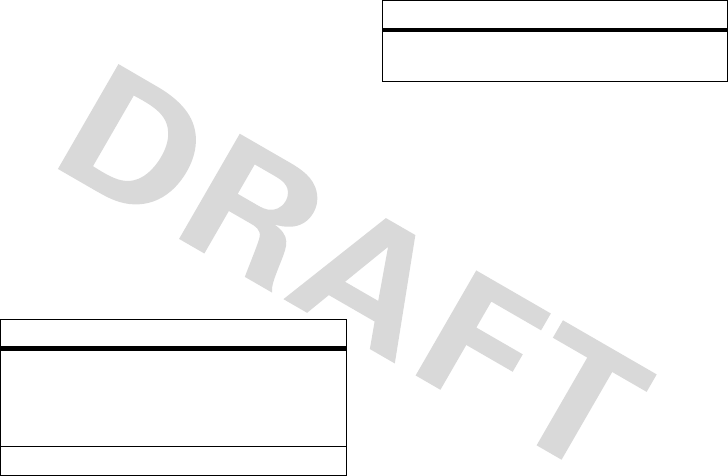
37
customize
Find it:
Start
>
PersonalizeMyQ
>
HomeScreenRightSoftKey
Press
Menu
to select a feature and enter a label
for your new right soft key function.
Note:
This option might be restricted or
unavailable if your home screen shows
scrolling headlines from your service provider.
start menu
You can customize your start menu.
Find it:
Start
>
Personalize My Q
>
Start Menu View
time & date
Your service provider usually sets the time
and date on your phone. To change
it manually:
Find it:
Start
>
Settings
>
Clock & Alarm
>
Date and Time
1
In
Time Zone
, use the navigation key
S
to
select your time zone.
Tip:
Update your time zone when you
travel to make sure your phone’s calendar
events appear at the right time.
2
In
Date
, edit the month, day, or year.
3
In
Time
, edit the hour, minute, and second.
options
Menu
Select the menu you want to
customize, then select which
icons to appear when you open
the start menu.
View
Select either a list or a grid view.
Background
Select a picture for your start
menu background image.
options

38
customize
4
Press
Done
to save the clock and
date settings.
You can specify the date and time style by
changing the regional settings. Press
Start
>
Settings
>
Regional Settings
.
backlight
To save battery life, your
backlight
turns off
when you’re not using your phone. The
backlight turns back on when you press a key.
To set how long your phone waits before the
backlight turns off:
Find it:
Start
>
Settings
>
Power Management
>
Backlight time out on battery
or
Backlight time out on AC
answer options
To u s e
any key
to answer an incoming call,
press
Start
>
Settings
>
Phone
>
Call Options
>
Any key answer
.
third-party applications
Third-party applications, or add-on programs,
can include e-mail, security, mobile office, and
productivity software. These products can
typically be downloaded and installed
immediately. Compatible commercial and free
applications are available on the Internet.
For more information, see the downloads
catalog on the Motorola Support Web site at:
www.motorola.com/consumer/support
,
or see your service provider’s Web site.

39
customize
Note:
Applications written for previously
released devices or older versions of
Windows Mobile may not function reliably on
this phone. Contact the application provider to
check compatibility before installing the
application on this phone.
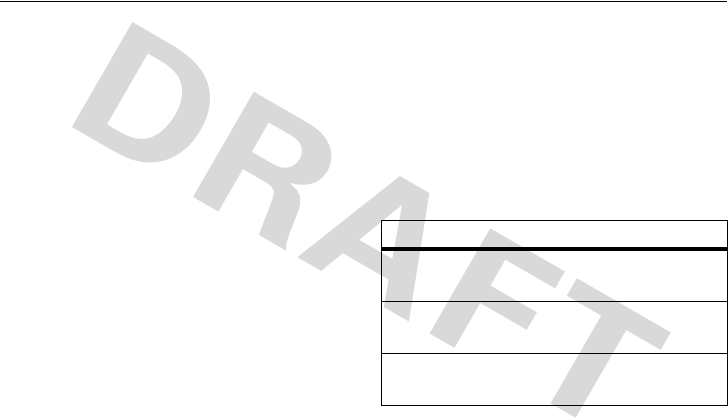
40
calls
calls
To make and answer calls, see page 22.
turn off a call alert
You can use the thumb wheel to turn off the
ringer before answering the call.
recent calls
Your phone keeps a list of incoming and
outgoing calls, even for calls that didn’t
connect. The most recent calls are listed first.
The oldest calls are deleted as new calls
are added.
Find it:
Start
>
Call History
Highlight a call, then:
•
To call the number, press
N
.
•
To see call details (like time and date),
press the center key
s
.
•
To see
Menu Options
, press
Menu
from the
Call History
view. This menu includes:
options
Find Contact
Find this phone number in your
Contacts
.
Send Text
Message
Send a text message to this
phone number.
E-mail
Send an e-mail message to this
contact.
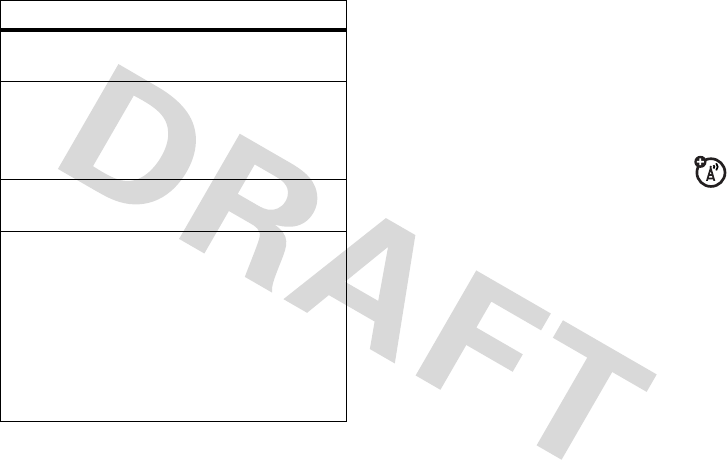
41
calls
redial
1
Press
N
from the home screen to see
the dialed calls list.
2
Highlight the entry you want to call, then
press
N
.
If you hear a
busy signal
and you see
Call Failed, Number Busy
, press
N
or the
RETRY
key to redial the number. When
the call goes through, your phone rings or
vibrates one time, shows
Redial Successful
, and
connects the call.
view missed calls
Your phone keeps a record of your
unanswered calls.
1
Press
Start
>
Call History
.
2
Press
Menu
>
Filter
>
Missed Calls
.
View Timers
View the call times for this call
and all calls.
Delete/
Delete List
Delete a call from the
Call History. Select
Delete List
to
delete all calls from the
call history.
Save to
Contacts
Save this number to a contact.
Filter
Filter all calls in the Call History
list. Filtering calls allows you to
group calls in a specific matter.
For example, if you filter the list
for all Missed Calls, all the
incoming phone calls that you
did not answer will be
listed first.
options

42
calls
caller ID
Calling line identification (caller ID)
shows the phone number for an
incoming call on your home screen.
Your phone shows the caller’s name and
picture if they are in your contacts, or
Incoming Call
when caller ID information
isn’t available.
You can set your phone to play a distinctive
ringer ID for specific entries in your contacts
(see page 81).
emergency calls
Your service provider programs one or more
emergency phone numbers, such as 911 or
112, that you can call under any
circumstances, even when your phone and
keypad are locked.
Note:
Emergency numbers vary by country.
Your phone’s preprogrammed emergency
number(s) may not work in all locations, and
sometimes an emergency call cannot be
placed due to network, environmental, or
interference issues.
1
Press the keypad keys to dial the
emergency number.
2
Press
N
to call the emergency number.
international calls
If your phone service includes
international dialing, press and hold
0
to insert your local international access
code (indicated by
+
). Then, press the keypad
keys to dial the country code and
phone number.

43
calls
speed dial
You can use speed dialing in two ways: quick
access for up to 98 phone numbers and
shortcuts to features found in the Start menu
including e-mail, calendar, and
Bluetooth Manager.
To access speed dial entries, press and hold
the single-digit speed dial number for one
second. If the speed dial is two digits, press
the first digit, then press and hold the second
digit. The phone dials the phone number,
opens a new e-mail message, or goes to the
Web page.
phone numbers
You can set the speed dial to call the entries in
your phone’s contact list:
1
Press
Start
>
Contacts
.
2
Scroll to the desired contact and press the
center key
s
.
3
Select the phone number or e-mail
address you want to add.
4
Press
Menu
>
Add to Speed Dial.
5
In the
Keypad Assignment
, select the speed
dial number to use.
Note:
Speed dial 1 is reserved for calling
your voicemail.
6
Press
Done
.
To
delete
a speed dial entry, press
Start
>
Speed
dial
, scroll to the entry, then press
Menu
>
Delete
.

44
calls
menu shortcuts
You can set a shortcut speed dial to open an
application on your phone:
1
Press
Start
.
2
Scroll to the icon of the application you
want a shortcut for and press
Menu
>
Add to
Speed Dial
.
3
In the
Keypad Assignment
, select the speed
dial number to use.
Note:
Speed dial 1 is reserved for calling
your voicemail.
4
Press
Done
.
To delete a shortcut, press
Start
>
Speed Dial
,
scroll to the shortcut, then press >
Menu
>
Delete
. Your service provider might add a
Voicemail
shortcut you cannot delete.
voicemail
Note:
Your service provider may include
additional information about using this
feature.
Your network stores the voicemail
messages you receive.
When you
receive
a voicemail message, your
phone shows the voicemail message
indicator
w
and
New Voicemail
.
To
check
voicemail messages:
Press and hold
1
.
Note:
You can’t store a pause (
p
) or wait (
w
)
character in your voicemail number. If you
want to store a voicemail number with these
characters, create a contact for your voicemail
number (see page 23) and use the contact to
call your voicemail.

45
calls
three-way calling
While connected to a call:
1
Place your current call on hold by
pressing
N
.
2
Enter the number of the other person you
wish to connect to a three-way call and
press
N
.
3
After you are connected to the other
phone, you can press
Swap
to switch
between the calls, or press
Menu
>
Conference
to combine them.
If you
receive a second call
while you are
already on a call:
•
To answer the second call and put the
first call on hold, press
Answer
. Then,
you can press
Swap
to switch between
the calls, or press
Menu
>
Conference
to
combine them.
•
To send the second call to your
voicemail, press
Ignore
.

46
messages
messages
If you have problems setting up e-mail or
synchronizing
, please visit
www.motorola.com/support/Q-gsm
or
call the Motorola Customer Support Center at
1-800-657-7576 (United States and Canada) or
1-888-390-6456 (TTY/TDD United States for
hearing impaired).
set up personal e-mail
After you know your e-mail
address
:
1
Press
Start
>
Messaging
>
New E-Mail Account
.
2
At
Your e-mail source
, select
Other
and press
Next
.
3
At
Your e-mail provider
, select
Other (POP/IMAP)
and press
Next
.
4
Enter your name and e-mail address,
select
Try to get e-mail server settings from internet
,
and press
Next
.
5
Enter your e-mail user name and
password.
6
Press
Next
. Press
Next
for each of the
following 5 screens, which are
automatically filled in.
Note:
If your e-mail settings are not
automatically available, contact your
e-mail provider to get the settings to
enter.
7
Press
Finish
>
Yes
to download e-mail now.

47
messages
set up MSN or Hotmail
e-mail
After you know your e-mail
address
and
password
:
1
Press
Start
>
Windows Live
>
Sign in to Windows Live
.
2
When prompted, enter your
e-mail address and password. Then, press
the
Next
soft key.
3
Choose the options you want and press
the
Next
soft key to proceed.
4
When synchronization is complete, press
the
Done
soft key.
set up corporate
e-mail
To set up corporate e-mail:
1
Press
Start
>
ActiveSync
.
2
Press
Menu
>
Configure Server
.
3
In
Server Address
, enter the exchange server
address.
Note:
You might be required to check
This
server requires an encrypted (SSL) connection
.
4
Press
Next
.
5
In
User Name
, enter your user name for the
e-mail account
6
In
Password
, enter the password for the
account.
7
In
Domain
, enter the server's domain name
(if necessary).

48
messages
Tip:
If you don’t want to enter your
password each time you synchronize,
check
Save Password
.
8
Press
Next
.
9
Choose the data you want to synchronize.
You can select
Contacts
,
Calendar
,
Email
,
and
Tasks
.
10
Press
Finish
.
11
Press
Sync
to synchronize your phone with
the Exchange server (see page 48).
Note:
If you don’t have some of the
information requested in these steps, contact
your company’s system administrator.
After you configure your synchronization
settings, you can modify your settings,
synchronization schedule, and connections.
Press
Start
>
ActiveSync
>
Menu
.
synchronize
Synchronize your phone to make sure you
have all of your most recent messages. You
can synchronize either over the air (OTA) or by
using a cable and your computer.
sync over the air
To sync your phone OTA, you must sync it
directly with your company’s e-mail server
(such as Microsoft® Information Server or
Microsoft® Exchange Server). For details, see
the support information on page 92 and the
MOTO Q support Web site at:
www.motorola.com/support/Q-gsm
.
You can also contact your system
administrator to set up this synchronization.
Note:
If you are out of network coverage, and
your phone tries to sync 3 times without
finding a network, your synchronization

49
messages
settings automatically revert to manual
synchronization. To set your synchronization
schedule back to the desired frequency, you
need to reset the
Schedule
option in the
Microsoft® ActiveSync settings:
On the home screen, press
Start
>
ActiveSync
>
Menu
>
Schedule
.
sync with a computer
Note:
For information about connections
(Bluetooth wireless, VPN, and Web browser),
see page 110.
You can use Microsoft®
ActiveSync
version 4.5 or above
, or Windows®
Mobile
Device Center
to synchronize information
between your phone and desktop computer.
ActiveSync compares your phone’s contact
information, calendar appointments, e-mail
messages, and media files with those on your
computer and then updates to the most
recent information.
installing and setting up ActiveSync
To synchronize information on your phone
with a computer, you must install
Microsoft ActiveSync (on a computer running
Windows® XP™ or earlier) or
Windows Mobile Device Center (on a
computer running Windows Vista).
Note:
Synchronization software is included on
the Getting Started CD packed with your
phone. Before installing the software, verify
that your computer and operating system
meet the
minimum requirements
stated on
the CD-ROM sleeve or Microsoft Windows®
Mobile Web site
http://www.microsoft.com/windowsm
obile
. This Web site also lets you download
the
latest software
for ActiveSync.
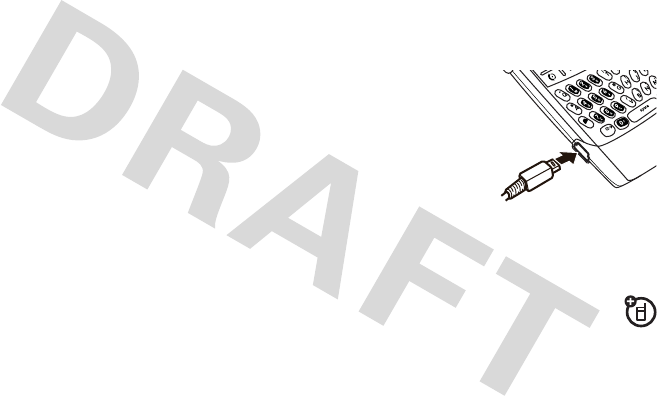
50
messages
1
Install Microsoft ActiveSync (for
Windows® XP™ or earlier) or
Windows Mobile Device Center (for
Windows Vista) on your computer.
2
After setup completes, connect your
phone to the computer. The phone drivers
install on your computer and then the
Sync Setup Wizard automatically starts.
3
Follow the instructions on the screen to
complete the wizard.
The wizard prompts you for the Exchange
Server’s name, your user name, your
password, and the domain name. If you
don’t have this information, contact the
server’s system administrator. For general
questions about your phone, see page 92.
When you finish the wizard, ActiveSync starts
to synchronize automatically with your phone.
Note:
After synchronization completes, you
can disconnect your phone from your
computer, and you may need to restart your
computer.
synchronizing with a cable connection
After Microsoft®
ActiveSync or
Windows® Mobile
Device Center is
installed on your
computer, you can
connect it to your
phone and sync.
1
Turn on the phone.
2
Connect your phone to your
computer using a USB cable.
Note:
For more detailed information, see
“Connecting a mobile device to a PC” in
ActiveSync Help on your computer, the

51
messages
Microsoft Web Site for ActiveSync or the
Motorola support Web site at
www.motorola.com/support/Q-gsm
.
synchronizing with a
Bluetooth connection
After you install Microsoft® ActiveSync or
Windows Mobile Device Center on your
computer, you can connect it to your phone
and sync with a Bluetooth connection.
Note:
To use this feature, your computer
must be equipped with Bluetooth wireless or
a Bluetooth PC adaptor accessory.
1
Follow the instructions in ActiveSync Help
for configuring Bluetooth connections on
your computer to support ActiveSync.
2
Turn on the phone.
3
On your phone, verify that
Bluetooth wireless is turned on. (Press
Start
>
Bluetooth
>
Bluetooth Manager
>
Settings
>
Status
>
Bluetooth On
.)
4
Press
Start
>
ActiveSync
.
5
Select
Menu
>
Connect via Bluetooth
. Ensure
that the phone and computer are near
each other. If this is the first time you have
connected to this computer using
Bluetooth wireless, you must complete
the Bluetooth wizard on the phone and
set up a Bluetooth partnership with the
computer before synchronizing.
6
Select
Sync
.
7
When finished, select
Menu
>
Disconnect Bluetooth
. To conserve battery
power on your phone, turn off
Bluetooth power (see page 62).

52
messages
receive & read
messages
When you receive a message your
phone plays an alert and shows
New Message
with a message indicator,
such as
C
.
Find it:
Start
>
Messaging
> (e-mail account).
If you do not see a list of messages
, press
Menu
>
Folders
>
Inbox
. To return to the folder list,
press
Menu
>
Folders
.
To read a message:
Press the
navigation key
S
to scroll to the message
and press the center key
s
to open it.
When you have a message open
, you can
press the navigation key
S
right to open the
next message, or left to open the
previous message.
message attachments
You can
send
,
read
, and
receive
PDF, ZIP,
Microsoft® Word, Excel, and PowerPoint files
attached to e-mail.
You can edit all Microsoft
files on your phone
, but you can only view
other files such as PDF and ZIP.
To see a ZIP file’s contents, select the file. You
can select files in the contents to view them,
if they are a format your phone supports.
To
transfer
attachments to your computer for
editing, use Microsoft® ActiveSync or
Windows® Mobile Device Center.

53
messages
message options
To delete, save, reply, or forward the
messages, use these quick steps from the
Inbox with a message selected or when
viewing a message:
•
To delete, press
Menu
>
Delete
.
•
To reply, press
Menu
>
Reply
or
Reply All
.
Enter the message and press
Send
.
•
To forward, press
Menu
>
Forward
. Enter
the message and press
Send
.
•
To create a contact card for the sender,
press
Menu
>
Save to Contacts
.
Tip:
Need to check your e-mail right now?
Press
Start
>
Messaging
. Select the account to
send and receive messages and press
Menu
>
Send/Receive
. The phone connects to your
e-mail server and sends and receives your
messages. To stop this process, press
Menu
>
Stop Send/Receive
.
send a message
You can send three types of messages:
SMS (text messages), MMS
(multimedia messages), and e-mail
messages.
Find it:
Start
>
Messaging
>
Text Messages
,
MMS
, or
(e-mail account)
To send a message:
1
Press
New
.
2
For e-mail, in
To
,
Cc
, and/or
Bcc
, enter e-mail
addresses. Insert a semicolon (;) between
multiple numbers or addresses.
For text messages, enter the contact
telephone number or e-mail address.
Tip:
You can quickly enter phone numbers
or e-mail addresses from your contact
cards. In
To
, press
j
and select a
recipient from the list. Then select the

54
messages
recipient's phone number or e-mail
address.
3
Use the keypad to compose a message.
4
Press
Send
.
Tip:
You can insert a
picture, voice note
or file
in an e-mail or MMS message.
When you are in a message, press
Menu
>
Insert
>
Picture
or
Voice Note
or
File
.
Note:
If you select to insert a voice note
into the message, you first need to record
it. Press
Record
and start speaking into the
phone's microphone. When finished
speaking, press
Stop
and then
Done
.
To set the priority for an e-mail message,
press
Menu
>
Message Options
.
To cancel a message, press
Menu
>
Cancel Message
.
global address
lookup
From your phone, you can search the global
address list (GAL) stored on your company's
Exchange Server. This means that you can
find a contact’s phone number or e-mail
without having to store the information
directly to your phone.
Note:
GAL information can only be viewed
during a data transfer session; the entire GAL
cannot be stored for viewing offline.
Find GAL Lookup in
Contacts
and
Contact Chooser
.
Contact Chooser
is in
Messaging
,
Phone
,
Calendar
and
Speed Dial
. To search for a contact:
1
Press
Start
>
Contacts
.
2
In the contact list, press
Menu
>
Company
Directory
.
3
Enter a name and press
Search
.
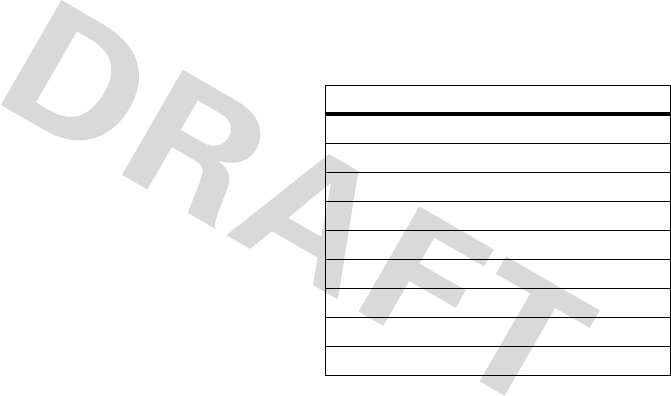
55
messages
4
Scroll through the list of entries that
appears. When you locate your contact,
press
N
to make a call.
Note:
Although the entire GAL cannot be
stored on your phone, after you find the
contact, you can add the single contact to
your contact list.
Tip:
You can also choose to send a message,
SMS or e-mail to a contact found using GAL.
In a new message or e-mail, press
Menu
>
Company Directory
. When you locate the contact
to send a message, highlight and select it.
The e-mail information is populated into the
To:
field.
messaging shortcuts
You can press the following keys to do things
quickly when you have an Inbox open. Press
and hold the keys if you have a
message open:
key function
0
(
H
)list shortcuts
1
(
A
) reply all
2
(
R
) reply
3
(
K
) mark read or unread
5
(
M
)move
6
(
O
)forward
7
(
D
) delete
8
(
L
) download
9
(
S
) send/receive
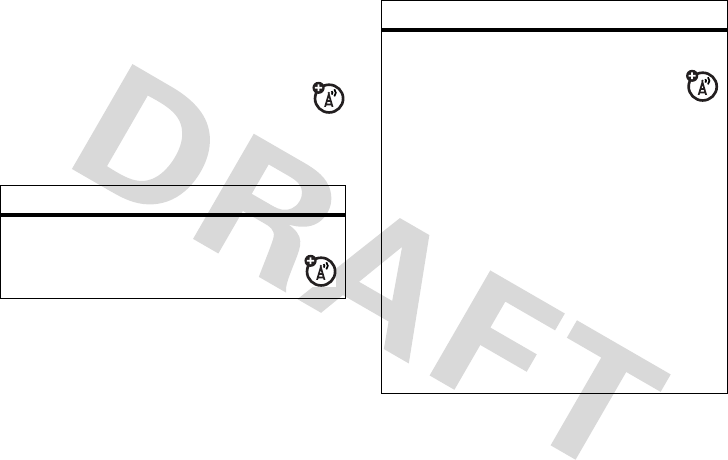
56
messages
messaging quick
reference
Note:
Some features might not work if
you set up your e-mail account
manually (without the e-mail
setup wizard).
features
send text message
Press
Start
>
Messaging
>
Text Messages
,
then press
New
create and send e-mail
Press
Start
>
Messaging
>(e-mail account), then press
New
Note:
You must have your e-mail set up to
send an e-mail (see page 46).
To add a picture, voice note, or file to an
e-mail message, open the message area
and press
Menu
>
Insert
>
Picture
,
Voice Note
,or
File
.
Tip:
You can save a draft of a message that
you are composing to finish and send later.
Press
Menu
>
Save to Drafts
. A draft of the
message is stored in the Drafts folder of the
account you are in.
features
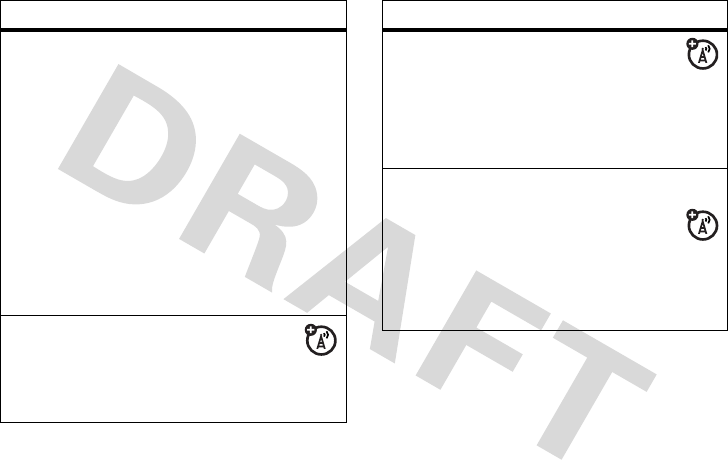
57
messages
create and add an e-mail signature
Press
Start
>
Messaging
> (e-mail account),
then press
Menu
>
Tools
>
Options
>
Signatures
Scroll to the account for which you are
creating the signature. Select
Use signature with
this account
. Select the
Signature
box, enter your
signature, and press
Done
.
Tip:
To insert a signature in every message
you send, select
Include when replying and
forwarding
. Otherwise, a signature is inserted
only in new messages.
read new messages
To quickly view new messages,
select the message notification area on the
home screen.
features
view attachment
While viewing the message, use the
center key
s
to select the attachment.
Note:
You can view attachments only for file
types that are supported by the phone.
read old messages
Press
Start
>
Messaging
>(e-mail account)
Icons next to each message show if it is
unread
J
,
read
H
,
urgent !
, or has an
attachment
y
.
features
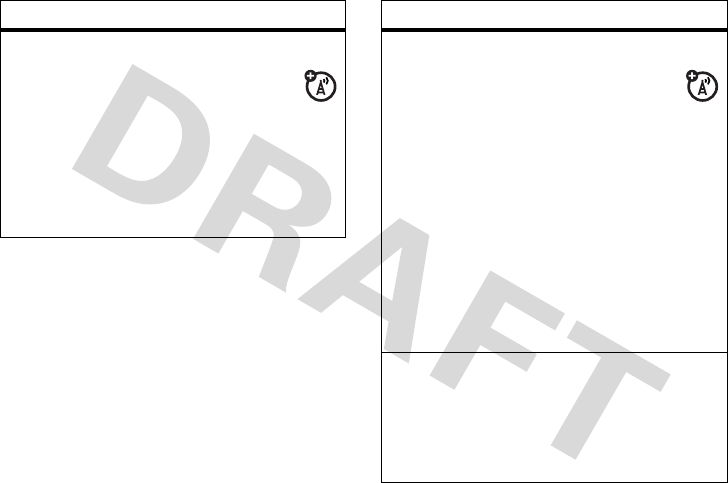
58
messages
reply, reply all or forward messages
From your Inbox or an open message,
press
Menu
>
Reply
,
Reply All
, or
Forward
Tip:
If you are replying to an e-mail in the
e-mail account, you will send less data if
you do not edit the original message. This
may reduce data transfer costs based on
your rate plan.
features
download message objects
If an e-mail message includes an
attachment, when you open the
message, the name of the
attachment will appear highlighted. To
download the attachment, select the
highlighted attachment name. The
attachment is downloaded the next time
you synchronize or connect to your e-mail
server.
Note:
If there are multiple attachments in
the message, all attachments
are downloaded.
insert a media object in an e-mail
To add a picture, voice note, or file in an
e-mail message, in the composing message
area press
Menu
>
Insert
>
Picture
,
Voice Note
or
File
.
features
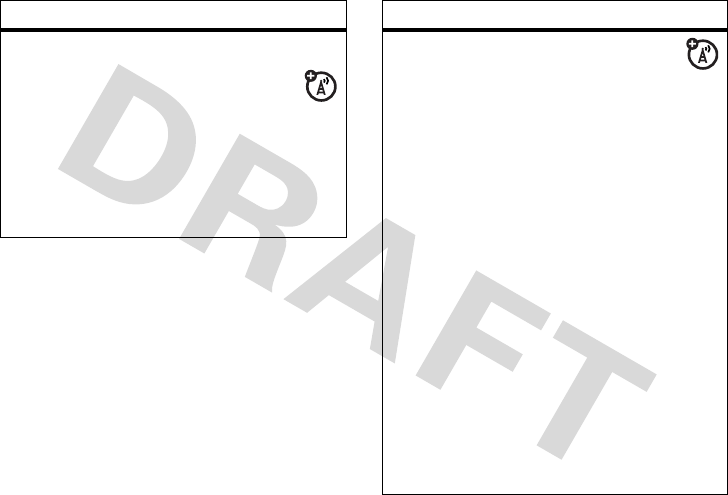
59
messages
download complete e-mail messages
Press
Start
>
Messaging
>(e-mail account). Scroll to the
message and press
Menu
>
Download Message
.
The complete message is retrieved the next
time you synchronize or connect to your
e-mail server and send and receive e-mail.
features
mark a folder for synchronization
When you synchronize your e-mail
account with your computer, the same
Inbox folders that are in Outlook on your
computer are created on your phone.
Press
Start
>
Messaging
> (e-mail account),
then press
Menu
>
Folders
>
Menu
>
Show all Folders
, and press
Menu
>
Manage Folders
Highlight each folder you want to
synchronize and press
Sync
.
After you select all folders, press
Done
. This
opens the
Manage Folders
view, where the
marked folders will be synchronized during
the next sync session.
Note:
Make sure to mark your e-mail sent
folder for synchronization, or you won’t be
able to view sent message status.
features
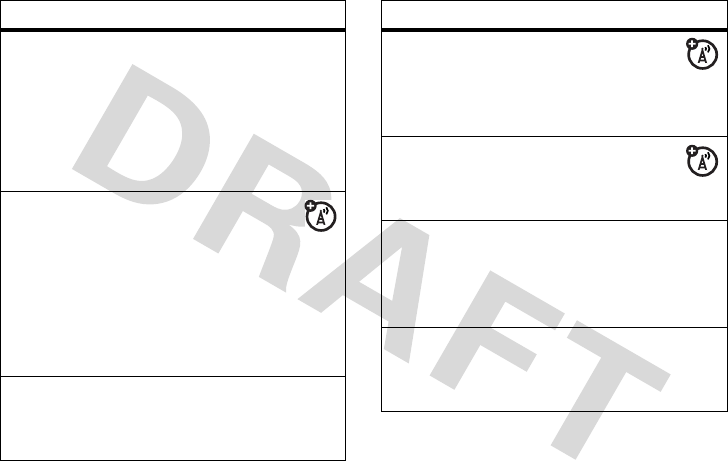
60
messages
view status of sent e-mail
Press
Start
>
Messaging
> (e-mail account)
Menu
>
Folders
>
Outbox
Messages in the
Outbox
have not been sent.
To send a message, scroll to it and press
Menu
>
Send/Receive
.
receive e-mail
If your phone is set up to
automatically check for new messages,
your phone will show
e
when a new
message arrives.
Scroll to the message and select it to
read it.
delete e-mail
From the Inbox or an open e-mail message,
press
Delete
(left soft key).
features
manually send and receive e-mail
Press
Start
>
Messaging
>(e-mail account), then press
Menu
>
Send/Receive
.
call a phone number in e-mail
Highlight a phone number in a
message and press
N
.
move e-mail to personal folder
After you’ve read the message, press
Menu
>
Move
then scroll to the folder you want to
move and select it.
delete a mail account
Press
Start
>
Messaging
, scroll to the e-mail
account, then press
Menu
>
Delete
.
features
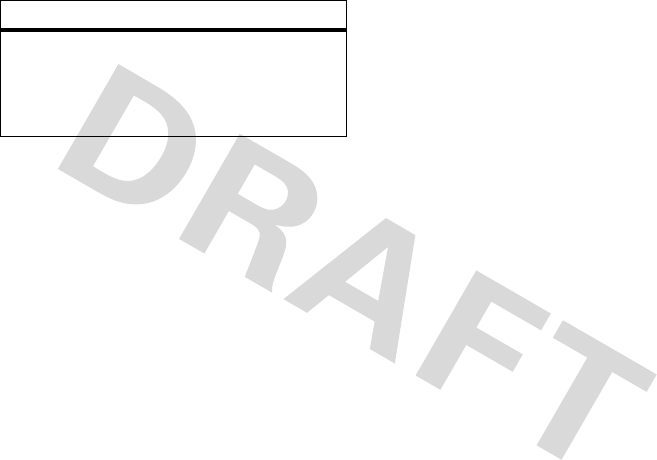
61
messages
empty deleted items folder
Press
Start
>
Messaging
> (e-mail account),
press
Menu
>
Folders
, scroll to
Deleted items
, then
press
Menu
>
Delete All
.
features

62
connections
connections
Bluetooth
™
wireless
Your phone supports Bluetooth wireless
pairing (also called linking or bonding). You can
pair your phone with a Bluetooth headset or
car kit, or pair your phone with a computer to
exchange and synchronize files.
Note: Your phone's Bluetooth features and
Bluetooth Class 1 power levels are not
allowed for outdoor operation in France. To
avoid unlawful interference with radio
signals, do not use the Bluetooth features
in France unless you are indoors.
turn Bluetooth power on or off
If Bluetooth
Power
is
On
, your phone can
automatically pair with the handsfree device
you have used before. Just turn on the device
or move it near the phone.To turn
Bluetooth on: Press
Start
>
Bluetooth
>
Bluetooth
Manager
>
Settings
then toggle
Status
to
Bluetooth ON
.
The Bluetooth indicator
O
appears in the
home screen.
Note:
To extend battery life, set
Bluetooth
Power
to
OFF
when not in use. Your
phone will not pair with devices until you set
Bluetooth
Power
back to
ON
and pair your phone
with the devices again.

63
connections
pair with a headset or
handsfree device
Before you try to pair your phone with a
device
, make sure your phone’s
Bluetooth power is
on
and the device is
on
and
ready
in pairing or bonding mode (see the
device user’s guide). You can pair your phone
with multiple devices, but only use it with one
headset device at a time.
Your phone lists the devices it finds within
range.
1
Press
Start
>
Bluetooth
>
Bluetooth Manager
>
Hands-free
.
2
Put the device (handsfree headset, stereo
headset, keyboard, etc.) in pairing mode.
3
Press
Add
. The phone prompts you to
verify your device is ready. Press
Search
.
4
Select the device from the list.
5
If prompted, enter the device passkey
(such as 0000) and press the
Accept
key.
When the devices are paired, an icon appears
on the home screen in the Bluetooth Task
Tray.
Tip:
For specific information about the
Bluetooth device you are using with your
phone, refer to the instructions that came
with it.
send objects to another device
You can use Bluetooth pairing to send
e-mail, contacts, tasks, calendar items,
audio, ring tones, pictures, video, and voice
notes from your phone to a computer or other
device.
1
Press
Start
>
Bluetooth
>
BT Send Object
.
2
Select the object type and object you
want to send.

64
connections
Tip:
To select an item, press the
center key
s
.
3
Press
Send
.
4
Select the name of the device to send the
file.
5
To cancel sending an item, press
Menu
>
Cancel
.
use your phone as a computer
remote
You can use Bluetooth wireless and
your phone as a remote control for your
computer. For example, want to watch a video
on your computer and use your phone as a
remote control? Use PC Remote to control
when the video plays, stops, or pauses.
1
On your computer, turn
Bluetooth power on.
2
On your phone, press
Start
>
Bluetooth
>
BT PC Remote
. If necessary, press
Yes
to
turn on Bluetooth power.
3
Press
Add
.
4
On your computer, right-click on the
Bluetooth indicator
O
in the system tray
in the lower right corner of your display.
Select
Bluetooth Setup Wizard
.
5
In the wizard, indicate that you know the
service you want to use, and you want to
find a Bluetooth device that provides the
service. Select Next.
6
In the next window, choose Human
Interface Device and select Next.
7
In the next window, make sure that
“Show all devices” is chosen in the
pull-down menu. Your computer should
find your “SmartPhone.” Select your
phone, and select Next.
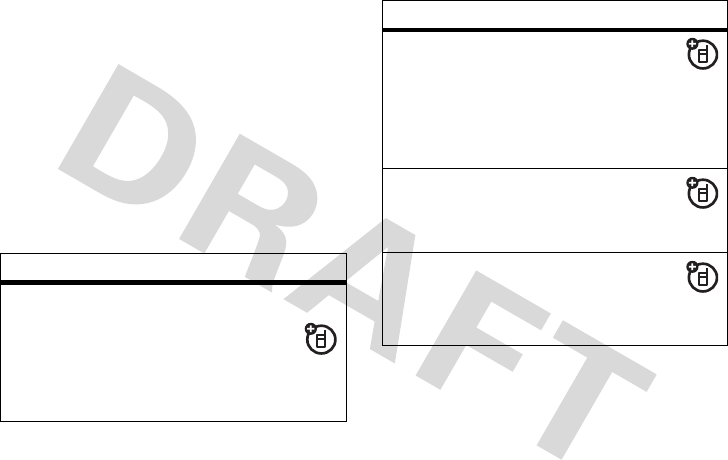
65
connections
8
If prompted, enter the device passkey
(such as 0000) and press the
Accept
key.
When PC Remote is connected, your phone
display shows a key map that tells you what
your keys control on the computer. To
determine which program on your computer
to control, on your phone, press
Menu
and
select a program.
advanced Bluetooth features
features
make phone visible to other device
Allow a Bluetooth device to discover
your phone:
Start
>
Bluetooth
>
Bluetooth Manager
>
Settings
, and
check
Allow other Bluetooth devices to see this phone
connect to recognized device
Connect to a recognized handsfree
device:
Start
>
Bluetooth
>
Bluetooth Manager
>
Hands-free
>device name
drop pairing with device
Start
>
Bluetooth
>
Bluetooth Manager
>
Hands-free
> device name >
Disconnect
send object to device
Send an object to another device:
Start
>
Bluetooth
>
BT Send Object
features
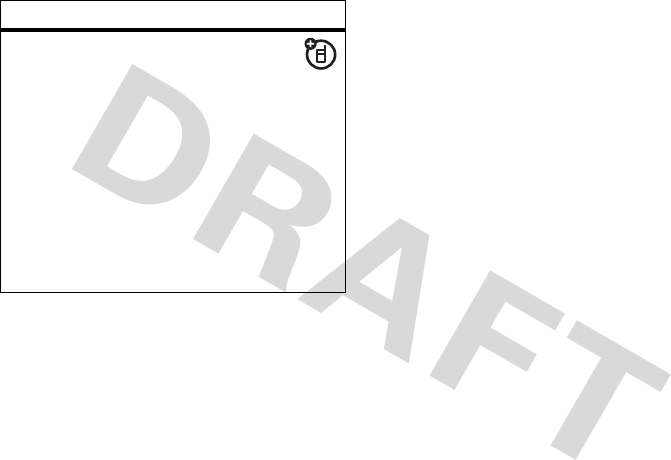
66
connections
Internet Sharing
You can use your phone to dial in to a
network. To do this, you need either a
Bluetooth wireless or USB cable connection.
Find it:
Start
>
More...
>
Settings
>
Internet Sharing
On your computer, you must have installed
ActiveSync 4.5 or later and have enabled a
Personal Area Network (PAN) server.
Note:
When you activate Internet Sharing,
your phone’s e-mail, Web browsing,
Microsoft® ActiveSync, and text messaging
services are suspended until you deactivate
Internet Sharing.
Internet Sharing with
Bluetooth® wireless
To use Bluetooth wireless to link to
anetwork:
Note:
You must have a computer that has
Bluetooth capabilities for Internet Sharing to
work with Bluetooth wireless.
1
To make sure other Bluetooth devices can
find your phone, you must first turn on
Bluetooth wireless.
On your phone
,
edit device properties / change
device name
Edit the properties of a recognized device:
Start
>
Bluetooth
>
Bluetooth Manager
>
Hands-free
>device name, then press
Menu
>
Properties
>
Nickname
Tip:
To change the Bluetooth name of your
phone, press
Start
>
Bluetooth
>
Bluetooth Manager
>
Settings
and enter the name in
My Bluetooth name
.
features

67
connections
press
Start
>
Bluetooth
>
Bluetooth Manager
>
Settings
then toggle
Status
to
Bluetooth ON
.
See Bluetooth wireless on page 56 for
more information.
2 On your computer
, launch the
Bluetooth devices applet from the
task bar.
Note:
Not all computers have the same
procedure to locate the Bluetooth window
and set up networking. Please refer to
your computer operating help system for
more information.
3
On your computer, right-click the
Bluetooth icon in the Windows task bar,
select the
Quick Connect
menu,
Dial-up
Networking
and then
Find devices
.
The computer finds your phone and
shows the dial up networking window.
4 On your phone
, press
Start
>
More...
>
Settings
>
Internet Sharing
.
5
Set
PC Connection
to
Bluetooth PAN
and click
Connect
.
The
Status
changes to
Connected
.
6
Press
Menu
>
Bluetooth Settings
and select
Personal Network
.
7
When you see the name of your computer
in the list of personal networks, select it
and press
Add
to establish a connection.
Internet Sharing with a cable
Note: Do not connect
your data cable to your
phone and computer until the following steps
tell you to do so.
To use a USB cable with your phone to
connect with Internet Sharing to a network,

68
connections
first you must install networking drivers onto
your computer.
On your computer:
1
Insert the provided Getting Started Disc
into the CD Drive on your computer. Your
computer automatically launches the
Getting Started Disc.
Note:
If you do not have the Getting
Started Disc, or want the latest version of
the device and computer drivers, go to
www.motorola.com/support/Q-gsm
.
2
In the Getting Started Disc application, go
to the Additional Tools screen and select
the
Dial-Up Networking Software
.
3
Follow the prompts to install the drivers
on your computer.
On your phone:
Now, you need to enable Internet Sharing on
your phone and install phone drivers:
1
On your phone, press
Start
>
More...
>
Settings
>
Connections
to set up the GPRS and Proxy
information as specified by your service
provider. These settings are the same as
for connecting to the internet.
2
Using the USB data cable, connect the
phone to your computer.
The driver is installed on your computer
and ready for setting up a network
connection.
3 On your phone
, press
Start
>
More...
>
Settings
>
Internet Sharing
.
4
Set
PC Connection
to
USB
and click
Connect
.
The
Status
changes to
Connected
.

69
connections
On your computer:
After you set up your computer and phone,
you can establish a new network connection
on your computer:
Note:
This procedure might not work on all
computers. Please refer to your computer
operating help system for more information.
1
Right-click on
My Computer
and select
Properties
.
2
Select the
Hardware
tab.
3
Press the
Device Manager
button.
4
Expand the
Modems
list.
5
Right-click
Smartphone Wireless USB
Modem
and select
Properties
.
6
Select the
Advanced
tab, and enter extra
initialization commands required by your
service provider. For details, contact your
service provider.
7
Select
Start
>
Control Panel
>
Network
and Internet Connections
>
Network
Connections
. In the Network
Connections window, select
Create a
new connection
under Network Tasks.
8
Follow the prompts to connect to the
Internet using a modem:
•
Network Connection Type:
Connect to the
Internet
•
Getting Ready:
Set up My Connection Manually
•
Internet Connection:
Connect using a dial-up
modem
•
Connection Name: Enter a unique
identifier for ISP name.
•
Number to Dial:
*99#
•
Connection Availability:
Anyone's Use
•
User Name: get this information from
your service provider as required

70
connections
•
Password: get this information from
your service provider as required
•
If you do not plan to use your phone as
the default Internet connection, then
do not
check
Make this the default Internet
connection
.
•
If Microsoft® Windows® firewall is not
enabled,
do not
check
Turn on Internet
connection firewall for this connection
.
Note:
You might need to deactivate your
computer proxy server settings to let
Internet Sharing access the Internet. To
deactivate these settings, open your Web
browser and select
Menu
>
Tools
>
Internet Options
>
Connections
>
Settings
>
Proxy
Server
, then deselect
Use a proxy server for
this connection
).
disconnect Internet Sharing
To disconnect Internet Sharing, perform these
steps on your computer and your phone.
On your computer
:
1
Go to task bar and right-click on the
Network Connection icon.
2
Select
Disconnect
.
Your computer disconnects Internet Sharing.
Note:
After you are no longer using Internet
Sharing, you may need to reactivate your
computer’s proxy settings. Please check with
your Internet provider.
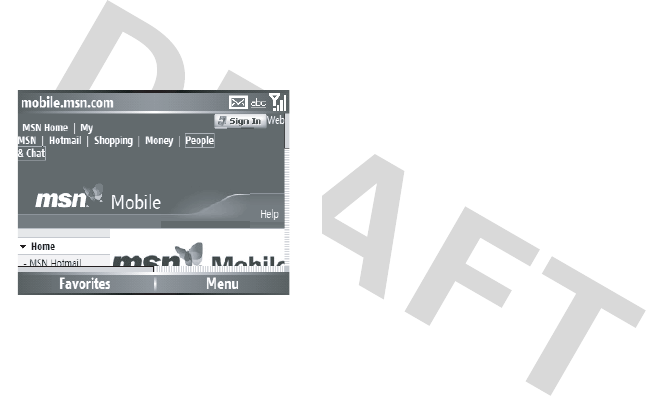
71
connections
Web browser
You can use Internet Explorer Mobile to
search and view the Web.
Find it:
Start
>
Internet Explorer
Note:
Not all Web file formats are supported.
•
To go to a Web page, press
Menu
>
Address Bar
. Enter the address and
press
Go
.
•
To go to a link in a Web page, use the
navigation key to highlight the link and
then press the center select key (
s
).
•
Change connection options, press
Menu
>
Tools
>
Options
>
Connections
.
•
To show/hide pictures, press
Menu
>
View
>
Show Pictures
.
•
To add Web address to your Favorites,
open the Web page and press
Menu
>
Add to Favorites
.
Tip:
You can use shortcut keys for browsing
the Web.
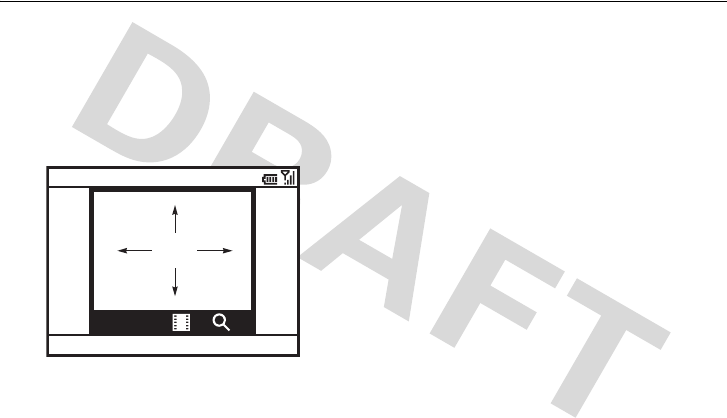
72
entertainment
entertainment
Have fun with your phone!
take & send a photo
Press
e
to open the camera viewfinder:
Tip:
In the camera viewfinder, press
Menu
to
adjust picture settings such as
mode
,
brightness
,
resolution
,
zoom
,
white
balance
, and
flash
.
1
Point the camera lens at the photo
subject.
2
Press
e
or the center key
s
to take a
photo. Your phone saves the picture and
shows it in the viewfinder.
3
Close the viewfinder or open the camera
options menu.
To close the viewfinder, press
O
. You
can see your stored picture by pressing
Start
>
Pictures & Videos
.
To see other camera options, press
Menu
:
•
To delete the photo and return to the
active viewfinder, select
Delete
.
Thumbnails
Pictures & Videos
Menu
877 1.0x
IMAGE
AREA

73
entertainment
•
To send the photo with
E-mail
,
select
Send
.
•
To send the photo with
Bluetooth wireless, select
Bluetooth
.
•
To use the picture as the home screen,
select
Use as Home Screen
.
•
To edit the picture, select
Edit
.
•
To view image properties, like the
filename, select
Properties
.
•
To view picture option, select
Options
.
Note:
To see your stored pictures, press
Start
>
Pictures & Videos
. Select the picture to view and
press
View
.
Tip:
To view pictures located in a folder other
than the default pictures folder, including a
storage card, press
Start
>
Pictures & Videos
, then
press
Menu
>
Folders
, and select the folder that
contains stored pictures.
self portrait
1
Press
e
to activate the camera.
2
Press
Menu
>
Mode
>
Timer
.
3
Press
e
to start the 5 second delay.
4
Aim the camera lens at yourself.
5
When you hear the camera shutter sound,
your phone takes the photo and shows it
in the viewfinder.
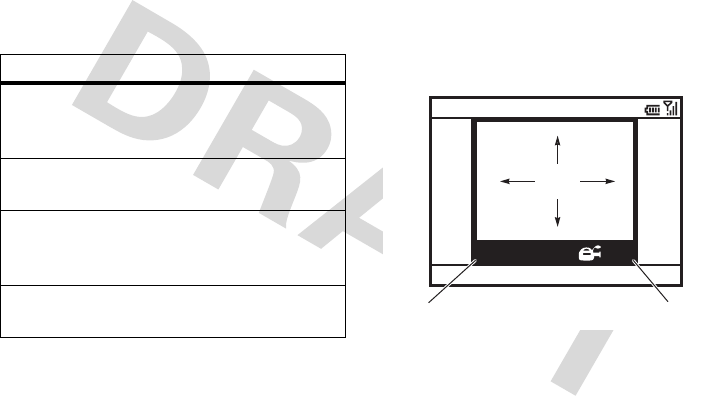
74
entertainment
picture options
In the picture viewfinder press
Menu
>
Options
to
open the
Picture Options Menu
. This menu can
include the following options:
record & play video
clips
record a video clip
Find it:
e
, then
Menu
>
Video
Tip:
In the video viewfinder, press
Menu
to
adjust video settings such as
still
,
brightness
,
quality
, and
white balance
.
option
General
Determine default picture sizes
for e-mail and rotating picture
settings.
Slide Show
Select default slide show
settings.
Camera
Select default locations to store
pictures, filename prefixes, and
image compression.
Video
Determine audio settings and
time limits for video files.
00:05 43:20
Stop
Pictures & Videos
Pause
VIDEO
AREA
Remaining recording time Current recording length
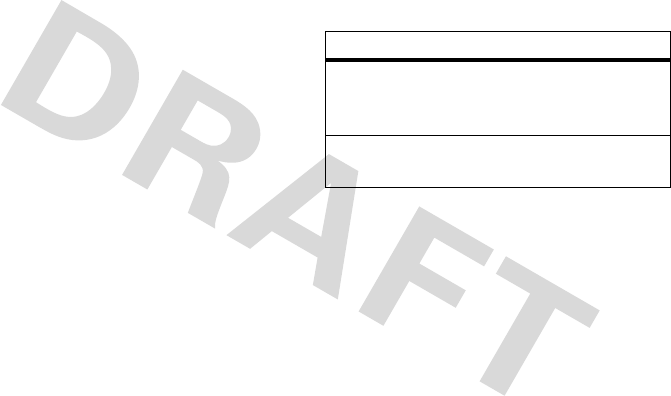
75
entertainment
1
Point the camera lens at the
photo subject.
2
Press
e
or the center key
s
to begin
recording a video. The viewfinder shows
what the video is recording.
3
Press
Stop
to end recording the video
altogether, or press
Pause
to pause
recording and
Resume
to
continue recording.
Note:
Videos are automatically stored in
your phone. To view them, press
Start
>
Pictures & Videos
. Select the video to view
and press
Play
or the center key
s
.
Tip:
To view videos located in a folder other
than the default video folder, including a
storage card, press
Start
>
Pictures & Videos
, then
press
Menu
>
Folder
, and then select the folder
that contains the stored videos.
video options
In the video viewfinder press
Menu
>
Options
to
open the video options menu:
Note:
General
and
Slideshow
options are also
available in this menu, however these settings
are specific to picture files only.
play a video clip
For more video playback and
Windows® Media Player features, see
page 76.
Find it:
Start
>
Pictures & Videos
> video clip >
Play
option
Camera
Select default save locations,
video filename prefixes, and
image compression.
Video
Determine audio and time limit
settings for video files.
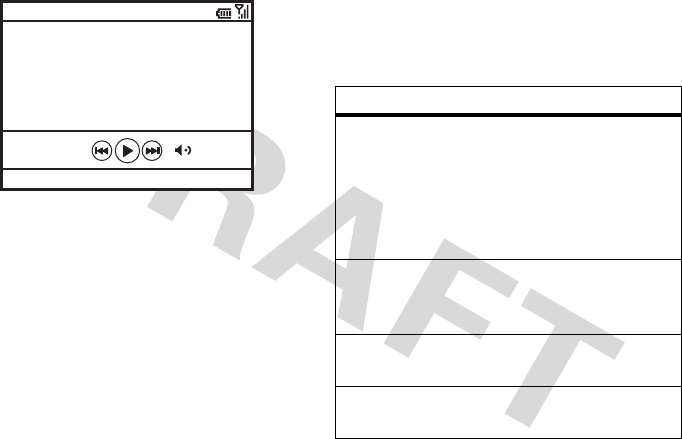
76
entertainment
The video clip plays in the
Windows Media Player
.
Tip:
To play video in full screen mode, press
Menu
>
Full Screen
. Videos recorded in a low
resolution may not play in full screen mode.
If a call comes in while watching a video, the
video pauses and a call alert appears. You can
choose to answer the call or ignore it. To
continue watching the movie, select the
Play
button.
video playback options
In the video playback window press
Menu
>
Options
to open the
Video Playback Menu
. This
menu can include the following options:
00:00 70%
Now Playing
Windows Media
Menu
option
Playback
Determines how the time
counter appears, whether to
pause playback while using
another program, and whether
to resume playback after a
phone call.
Video
Options for showing in full
screen and when to scale to fit
window.
Network
Selects default network settings
for streaming media.
Library
Determines if the player starts
on the
Library
view.
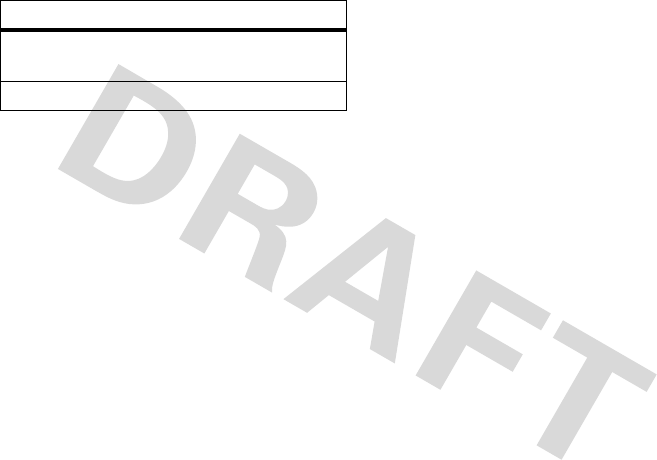
77
entertainment
download & copy
media files
You can copy or download media files from
your computer or the Internet onto
your phone.
copy files from your computer
To copy files from your computer to
your phone:
Note:
You must have Microsoft® ActiveSync
or Windows® Mobile Device Center installed
on your computer, as described on page 49.
1
Connect the phone to your computer.
2
In ActiveSync on your computer, select
Explore
and double-click
My Windows
Mobile
device.
3
On your computer, find the files you
would like to copy to your device and
paste the files into the
My Windows
Mobile
folder.
4
Resync your phone and computer and
then view the picture or video on your
phone from
Start
>
Pictures & Videos
.
Skins
Determine Windows® Media
Player skin theme.
Buttons
Set playback button mapping.
option
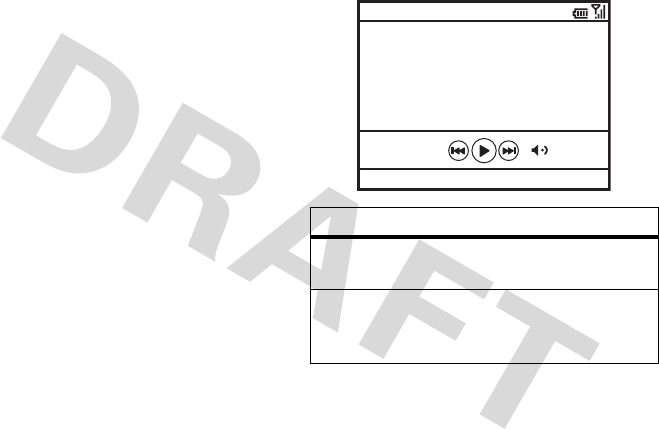
78
entertainment
media player
A version of Windows® Media Player Mobile
version 10.2 or higher for Smartphone is
available on your to phone to play digital audio
and video files that are stored on your phone
or on the Web.
Windows Media Player Mobile can play the
following types of files: Windows Media
Audio (WMA), Windows Media Video (WMV),
MP3, AAC, eAAC, eAAC+, WAV, and
Real Audio.
Find it:
Start
>
Windows Media
control
play/
pause
To play or pause a music or
video file, press
j
.
skip ahead or
go back
To skip to the previous or next
file, press the
navigation key
S
left or right.
00:00 70%
Now Playing
Windows Media
Menu
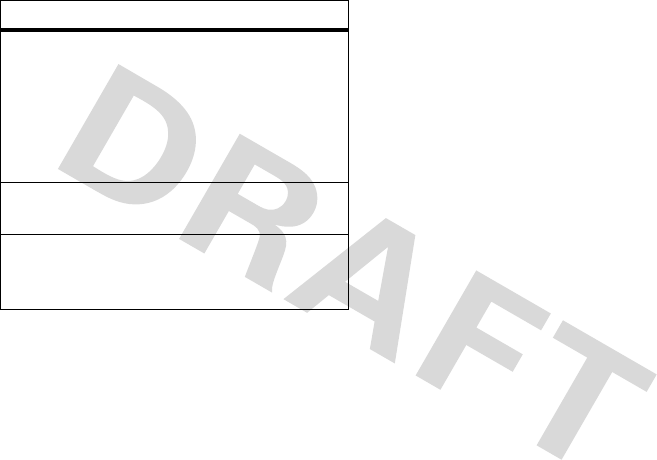
79
entertainment
To listen through a stereo Bluetooth headset,
see page 63.
Tip:
Do you want to play a song or video on
the Internet or network? Use the Open URL
command. From the
Library
view, press
Menu
>
Open URL
(if you need to get to the
Library
view,
in
Windows Media Player
, press
Menu
>
Library
). For
more information about downloading or
copying video files, see page 77.
set video controls
You can set up keys on your phone to control
the media player.
1
From the media player, press
Menu
and
select
Options
.
2
Select
Buttons
.
3
Scroll to the media player action you want
to assign a button or key press.
4
Press
Menu
and choose
Assign
,
Reset
, or
None
.
5
After you have assigned key presses to
the medial player controls, press
OK
and
Done
to complete the set up.
volume
To increase or decrease the
volume, press the
navigation key
S
up or down.
Tip:
To turn the sound off
quickly, press
#
. Press
#
to
turn the sound back on.
switch to full
screen
To switch to full screen video
playback, press
0
.
fast forward/
rewind
To fast forward or rewind, press
and hold the navigation key
S
left or right.
control
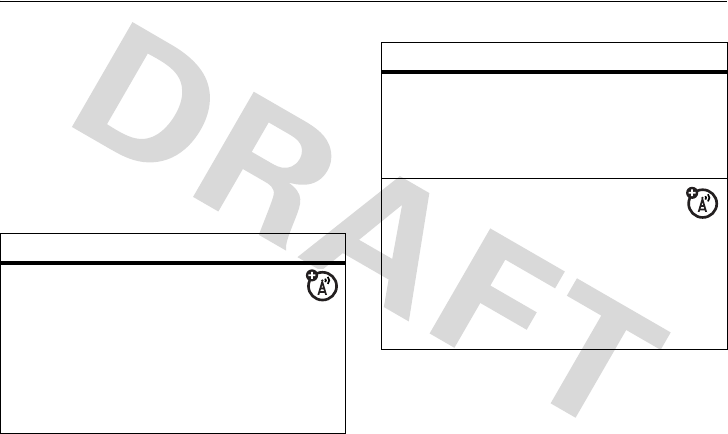
80
other features
other features
Note:
To open the main menu from your
home screen, press
Start
. To scroll through the
pages of menu options, press the
navigation key
S
down. To select a menu
option, press the center key
s
.
advanced calling
features
call forwarding
Set up or cancel call forwarding:
Start
>
Settings
>
Phone
>
Call Forwarding
Note:
If you choose
No Reply
, you can set
how many seconds your phone waits
before it forwards a call.
voice dial
To voice dial, press and hold
h
in your
home screen. When prompted, say “Call,”
followed by a number or contact name.
TTY calls
Set up your phone for use with an
optional TTY device:
Start
>
Settings
>
Phone Accessibility
>
TTY
Note:
TTY does not work from mobile
phone to mobile phone.
features
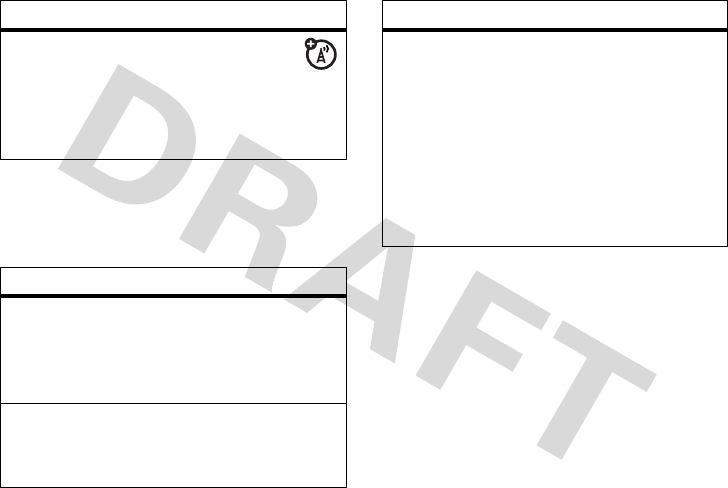
other features—contacts
81
contacts
To store and call contacts, see page 23.
call a phone number in a message
E-mail or text messages can contain
phone numbers that have an underline, like
a Web site hyperlink. To dial one of these
numbers, scroll to it and press
N
.
features
search for contact
Enter the first few letters of the contact's
name. The phone searches through the
contact list and shows the name.
edit contact
Start
>
Contacts
, scroll to a contact, then press
Menu
>
Edit
features
set ringer ID for a contact
Note:
You cannot store a ringer ID for
SIM Contacts.
To easily identify who is calling you by the
ring tone, you can assign a custom ring
tone to each contact.
Start
>
Contacts
, scroll to a contact, then press
Menu
>
Edit
and scroll to
Custom Ring Tone
features
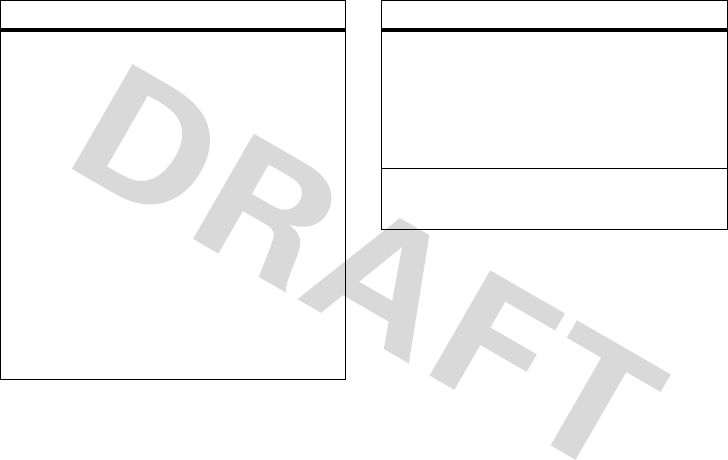
82
other features—contacts
set picture ID for contact
Note:
You cannot store a picture ID for
SIM Contacts.
Assign a photo or picture to appear when
you receive a call from an entry:
Start
>
Contacts
, scroll to a contact, then press
Menu
>
Edit
and then scroll to
Picture
Select a picture, or select
Camera
to take a
new picture for the contact.
Tip:
Want to remove a picture ID? Press
Start
>
Contacts
, scroll to a contact, press
Menu
>
Edit
, then scroll to
Picture
and press
Menu
>
Remove Picture
.
features
set category for contact
Note:
You cannot store a category for
SIM Contacts.
Start
>
Contacts
, scroll to a contact, then press
Menu
>
Edit
and scroll to
Categories
set category view
Start
>
Contacts
, then press
Menu
>
Filter
features
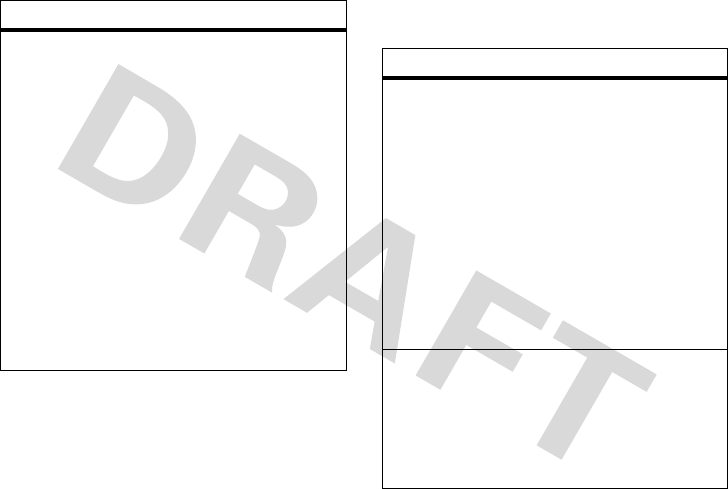
other features—personalizing
83
personalizing
send contact to another device
Use a Bluetooth connection to send a
contact to another phone, computer,
or device:
Start
>
Contacts
, scroll to a contact, and press
Menu
>
Send via Bluetooth
If necessary, your phone asks you to turn on
Bluetooth power. Your phone searches for
Bluetooth devices. Select the one you want
and press the center key
s
. Your phone
tells you when the transfer is complete.
For more about Bluetooth connections, see
page 62.
features
features
language
Set menu language:
Start
>
Settings
>
Regional Settings
Note:
You must turn your phone off and on
again for the changes to take effect.
Tip:
While you enter text (such as in a text
message), your phone suggests words. To
change the language for these suggestions,
press
Menu
>
Languages
in the text entry
screen.
accessibility
You can set system font size, multipress
timeout, confirmation timeout, and in-call
alerts:
Start
>
Settings
>
Accessibility
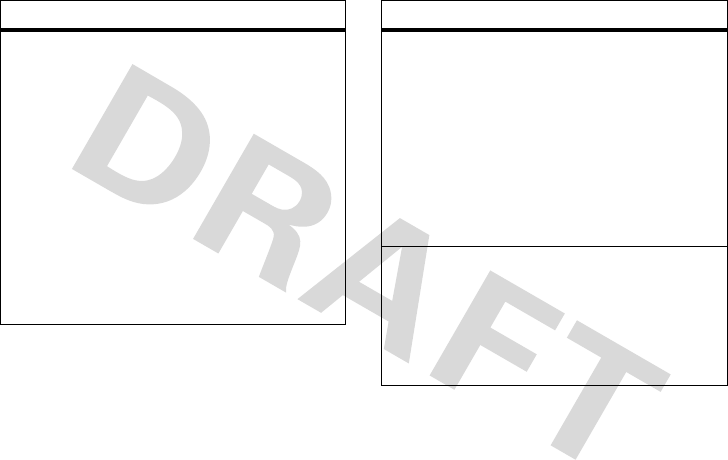
84
other features—personalizing
ring volume
Start
>
Settings
>
Profiles
Highlight the desired profile, then press
Menu
>
Edit
Under
Ring Volume
, press the
navigation key
S
left or right to adjust the
volume for that profile.
Tip:
You can eliminate the ringer volume
instantly when an incoming call comes
in--just use the thumb wheel to turn the
ringer off.
features
sounds
To change the default sounds for ring tone,
reminders, new messages, alarm clock, or
keypad controls:
Start
>
Settings
>
Sounds
Note:
Changes made to the alert settings
will have no effect when using the
Silent
profile.
alarm
Start
>
Settings
>
Clock & Alarm
>
Alarm
Tip:
Need to change or set the alarm alert
style? Press
Start
>
Settings
>
Sounds
>
Alarm Clock
.
features
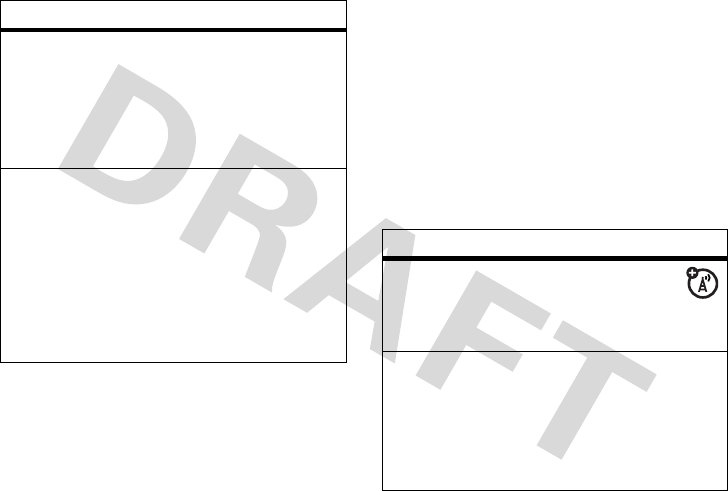
other features—call times
85
call times
Network connection time
is the elapsed
time from the moment you connect to your
service provider's network to the moment
you end the call by pressing
O
. This time
includes busy signals and ringing.
The amount of network connection time
you track on your resettable timer may not
equal the amount of time for which you
are billed by your service provider. For
billing information, contact your service
provider.
owner information
It’s a good idea to enter and check your
owner information. It lets someone return
the phone to you if you lose it:
Start
>
Settings
>
Owner Information
master reset
To return your phone to original settings:
Start
>
System Tools
>
Master Reset
The default master reset code is
000000
(6 zeroes).
Master reset does not reset the unlock
code, security code, and lifetime timer.
features
features
see call timers
Show call timers:
Start
>
Call History
, then press
Menu
>
View Timers
reset call timers
To reset all call timers to zero (0), except for
the
Lifetime calls
timer:
Start
>
Call History
, then press
Menu
>
View Timers
,
then press
Menu
>
Reset Timers
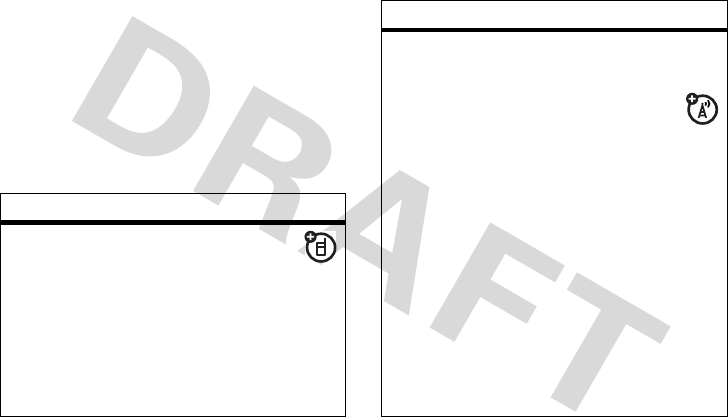
86
other features—handsfree
handsfree
Note:
The use of wireless phones while
driving may cause distraction. Discontinue a
call if you can’t concentrate on driving.
Additionally, the use of wireless devices and
their accessories may be prohibited or
restricted in certain areas. Always obey the
laws and regulations on the use of
these products.
network connections
features
speakerphone
Activate a connected external
speakerphone during a call:
Press
h
or press
Menu
>
Speakerphone On
.
Note:
With a Bluetooth headset press
Menu
>
Handsfree Off
and then press
Menu
>
Speakerphone On.
features
create proxy, Virtual Private Network
(VPN), or dial-up network
A Virtual Private Network lets you
connect securely to your enterprise
through IPsec. This connection
requires a policy definition from your IT
department. Your IT department can send
you the policy in a file, or give you the policy
to enter manually. After you receive the
policy file or information:
Start
>
Settings
>
Connections
>
VPN
Select a policy to open a connection, or
press
Menu
>
New
to manually enter a new
policy definition.
To close the secure connection, press
Logoff
.
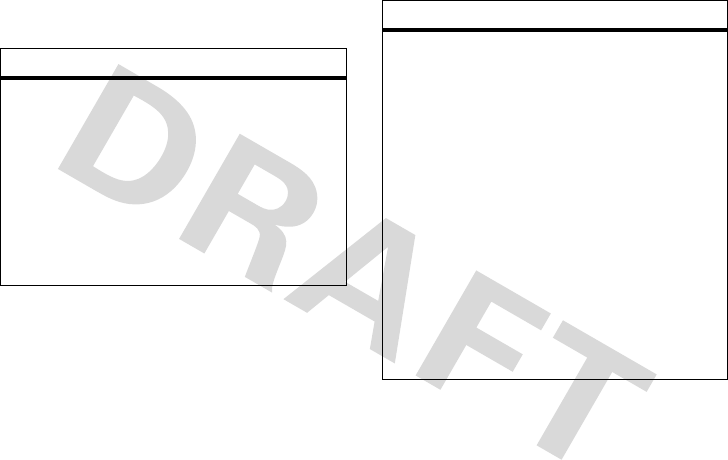
other features—calendar
87
calendar
features
add new calendar event
Start
>
Calendar
, then press
Menu
>
New Appointment
Note:
To schedule an all-day event, select
the
All day event
check box under
End time
.
All-day events do not occupy blocks of time
in the calendar; instead, they appear in
banners at the top of the calendar.
view calendar event
Press
Start
>
Calendar
to open the calendar for
today.
•
To see days before or after today,
press the navigation key
S
left or
right.
•
To quickly see a specific date, press
Menu
>
Go to Date
.
•
To see your whole week’s events,
press
Week
.
Shortcut:
Today’s events appear on your
home screen. To see event details, scroll to
it and press the center key
s
.
features
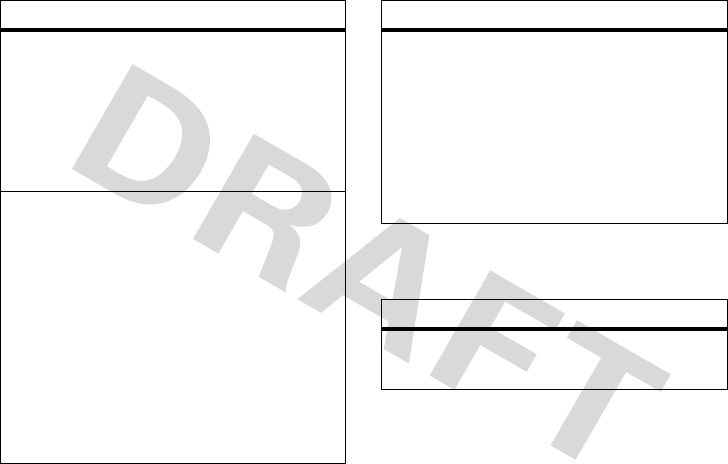
88
other features—memo pad
memo pad
calendar event reminder
The default reminder time for tasks and
calendar items is 15 minutes. To change
this default:
Start
>
Calendar
, then press
Menu
>
Tools
>
Options
>
Set Reminders
send calendar event to another device
Use a Bluetooth connection to send a
calendar event to another phone, computer,
or device:
From the calendar item, press
Menu
>
Send via Bluetooth
.
Select the device to which you want to
send the item.
For more about Bluetooth connections, see
page 62.
features
respond to a meeting request
You can receive and respond to meeting
requests on your phone in a similar manner
as you do in Outlook on your computer.
Start
>
Messaging
> (e-mail account)
>meeting request
Accept
or
Menu
>
Decline
or
Tentative
features
memo pad
Start
>
Accessories
>
Memo Pad
features
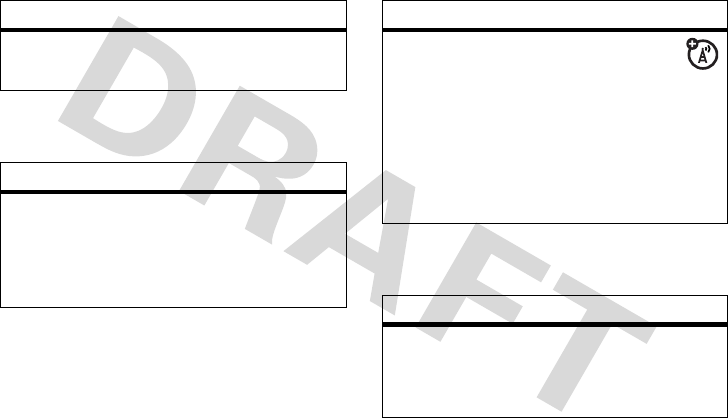
other features—calculator
89
calculator
converter
security
phone information
features
calculator
Start
>
Accessories
>
Calculator
features
converter
To quickly convert currency, time, or other
measurements:
Start
>
Accessories
>
Converter
features
manage certificates
Enable or disable Internet access
certificates stored on your phone:
Start
>
Settings
>
Security
>
Certificates
Certificates are used to verify the identity
and security of Web sites when you
download files or share information.
features
software version
To view your phone software version:
Start
>
Settings
>
About
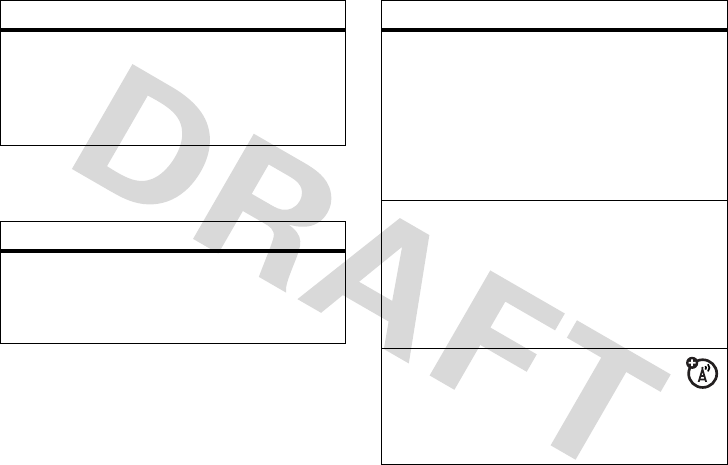
90
other features—fun & games
fun & games
memory & storage
To see the total, used, and available
memory on your phone and storage card:
Start
>
System Tools
>
Memory Manager
features
manage pictures
Manage pictures:
Start
>
Pictures & Videos
features
manage sounds
Manage ring tones and music that you have
downloaded or composed:
Start
>
Windows Media
For more information about Windows®
Media, see page 78.
manage video clips
Manage video clips:
Start
>
Pictures & Videos
For more information about Windows®
Media, see page 78.
start Web browser
Start
>
Internet Explorer
For more information about Internet
Explorer Mobile, see page 71.
features
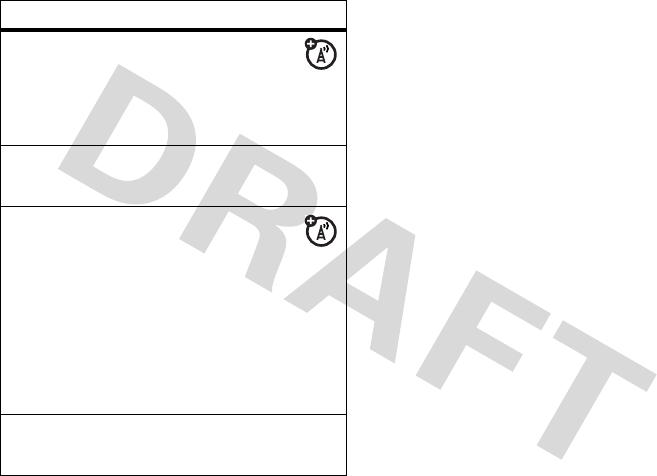
other features—fun & games
91
use Web browser shortcut keys
For more information about Internet
Explorer Mobile, see page 71.
close Web browser
In the browser, press
Menu
>
Exit
download objects from Web page
To download a picture, sound, or
phone theme from a Web page: Highlight
the file, press the
Select
key, then press the
Store
key.
To download a picture or other object from a
Web page: Highlight the item, press
Menu
,
and choose an option such as
Save image
.
play games on your phone
Start
>
Games
features

92
service & repair—fun & games
service & repair
Tip:
Motorola Software Update is an easy
way to update your phone. Make sure you
have the latest available software updates at
www.motorola.com/support/Q-gsm
.
If you have questions or need assistance,
we're here to help.
Motorola Support:
Go to
www.motorola.com/support/Q-gsm
,
where you can select from a number of
customer care options. You can also contact
the Motorola Customer Support Center at
1-800-657-7576 (United States and Canada) or
1-888-390-6456 (TTY/TDD United States for
hearing impaired).
Microsoft® Windows® Mobile and
ActiveSync Support:
Windows Smartphone:
http://www.microsoft.com/
windowsmobile/help/smartphone/

93
service & repair
Specific Absorption Rate Data
SAR Da ta
This model meets international guidelines for
exposure to radio waves.
Your mobile device is a radio transmitter and receiver. It is
designed not to exceed the limits for exposure to radio waves
recommended by international guidelines. These guidelines were
developed by the independent scientific organization ICNIRP and
include safety margins designed to assure the protection of all
persons, regardless of age and health.
The guidelines use a unit of measurement known as the Specific
Absorption Rate, or SAR. The ICNIRP SAR limit for mobiles devices
used by the general public is 2 W/kg and the highest SAR value for
this device when tested at the ear was ___ W/kg.
1
As mobile
devices offer a range of functions, they can be used in other
positions, such as on the body as described in this user guide.
2
In
this case, the highest tested SAR value is ___ W/kg.
1
As SAR is measured utilizing the device’s highest transmitting
power, the actual SAR of this device while operating is typically
below that indicated above. This is due to automatic changes to
the power level of the device to ensure it only uses the minimum
level required to reach the network.
While there may be differences between the SAR levels of various
phones and at various positions, they all meet the governmental
requirements for safe exposure. Please note that improvements to
this product model could cause differences in the SAR value for
later products; in all cases, products are designed to be within the
guidelines.
The World Health Organization has stated that present scientific
information does not indicate the need for any special precautions
for the use of mobile devices. They note that if you want to reduce
your exposure then you can do so by limiting the length of calls or
using a “hands-free” device to keep the mobile phone away from
the head and body.
Additional Information can be found on the websites of the World
Health Organization (
http://www.who.int/emf
) or
Motorola, Inc.
(
http://www.motorola.com/rfhealth
).
1. The tests are carried out in accordance with international guidelines for
testing. The limit incorporates a substantial margin for safety to give
additional protection for the public and to account for any variations in
measurements. Additional related information includes the Motorola
testing protocol, assessment procedure, and measurement uncertainty
range for this product.
2. Please see the Safety and General Information section about body worn
operation.
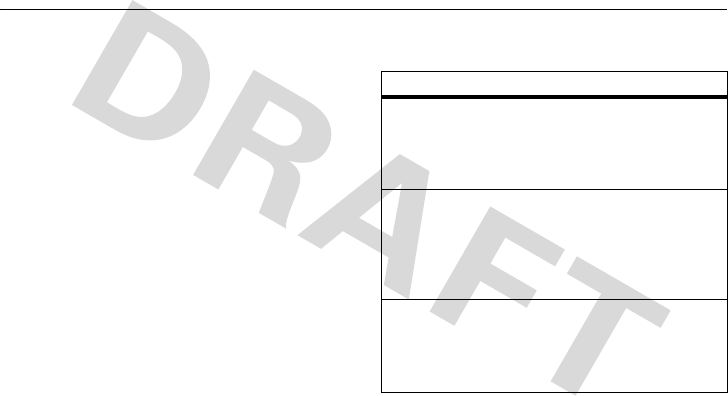
94
Warranty
Motorola Limited Warranty for the United States and
Canada
Warran ty
What Does this Warranty Cover?
Subject to the exclusions contained below, Motorola, Inc. warrants
its telephones, pagers, messaging devices, and consumer and
professional two-way radios (excluding commercial, government
or industrial radios) that operate via Family Radio Service or
General Mobile Radio Service, Motorola-branded or certified
accessories sold for use with these Products (“Accessories”) and
Motorola software contained on CD-ROMs or other tangible media
and sold for use with these Products (“Software”) to be free from
defects in materials and workmanship under normal consumer
usage for the period(s) outlined below. This limited warranty is a
consumer's exclusive remedy, and applies as follows to new
Motorola Products, Accessories and Software purchased by
consumers in the United States or Canada, which are accompanied
by this written warranty:
Products and Accessories
Products Covered Length of Coverage
Products and
Accessories
as
defined above, unless
otherwise provided for
below.
One (1) year
from the date of
purchase by the first consumer
purchaser of the product unless
otherwise provided for below.
Decorative
Accessories and
Cases.
Decorative
covers, bezels,
PhoneWrap™ covers
and cases.
Limited lifetime warranty
for the
lifetime of ownership by the first
consumer purchaser of the product.
Monaural Headsets.
Ear buds and boom
headsets that transmit
mono sound through a
wired connection.
Limited lifetime warranty
for the
lifetime of ownership by the first
consumer purchaser of the product.
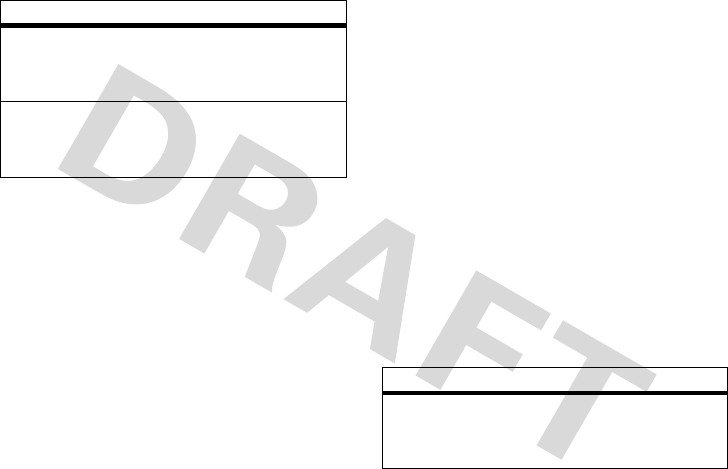
Warranty
95
Exclusions
Normal Wear and Tear.
Periodic maintenance, repair and
replacement of parts due to normal wear and tear are excluded
from coverage.
Batteries.
Only batteries whose fully charged capacity falls below
80% of their rated capacity and batteries that leak are covered by
this limited warranty.
Abuse & Misuse.
Defects or damage that result from:
(a) improper operation, storage, misuse or abuse, accident or
neglect, such as physical damage (cracks, scratches, etc.) to the
surface of the product resulting from misuse; (b) contact with
liquid, water, rain, extreme humidity or heavy perspiration, sand,
dirt or the like, extreme heat, or food; (c) use of the Products or
Accessories for commercial purposes or subjecting the Product or
Accessory to abnormal usage or conditions; or (d) other acts which
are not the fault of Motorola, are excluded from coverage.
Use of Non-Motorola Products and Accessories.
Defects or
damage that result from the use of Non-Motorola branded or
certified Products, Accessories, Software or other peripheral
equipment are excluded from coverage.
Unauthorized Service or Modification.
Defects or damages
resulting from service, testing, adjustment, installation,
maintenance, alteration, or modification in any way by someone
other than Motorola, or its authorized service centers, are
excluded from coverage.
Altered Products.
Products or Accessories with (a) serial
numbers or date tags that have been removed, altered or
obliterated; (b) broken seals or that show evidence of tampering;
(c) mismatched board serial numbers; or (d) nonconforming or
non-Motorola housings, or parts, are excluded from coverage.
Communication Services.
Defects, damages, or the failure of
Products, Accessories or Software due to any communication
service or signal you may subscribe to or use with the Products
Accessories or Software is excluded from coverage.
Software
Consumer and
Professional
Two-Way Radio
Accessories.
Ninety (90) days
from the date of
purchase by the first consumer
purchaser of the product.
Products and
Accessories that are
Repaired or
Replaced.
The balance of the original
warranty or for ninety (90) days
from the date returned to the
consumer, whichever is longer.
Products Covered Length of Coverage
Products Covered Length of Coverage
Software.
Applies only to physical
defects in the media that embodies
the copy of the software (e.g.
CD-ROM, or floppy disk).
Ninety (90) days
from
the date of purchase.

96
Warranty
Exclusions
Software Embodied in Physical Media.
No warranty is made
that the software will meet your requirements or will work in
combination with any hardware or software applications provided
by third parties, that the operation of the software products will be
uninterrupted or error free, or that all defects in the software
products will be corrected.
Software NOT Embodied in Physical Media.
Software that is
not embodied in physical media (e.g. software that is downloaded
from the internet), is provided “as is” and without warranty.
Who Is Covered?
This warranty extends only to the first consumer purchaser, and is
not transferable.
What Will Motorola Do?
Motorola, at its option, will at no charge repair, replace or refund
the purchase price of any Products, Accessories or Software that
does not conform to this warranty. We may use functionally
equivalent reconditioned/refurbished/pre-owned or new Products,
Accessories or parts. No data, software or applications added to
your Product, Accessory or Software, including but not limited to
personal contacts, games and ringer tones, will be reinstalled. To
avoid losing such data, software and applications please create a
back up prior to requesting service.
How to Obtain Warranty Service or
Other Information
You will receive instructions on how to ship the Products,
Accessories or Software, at your expense, to a Motorola
Authorized Repair Center. To obtain service, you must include: (a) a
copy of your receipt, bill of sale or other comparable proof of
purchase; (b) a written description of the problem; (c) the name of
your service provider, if applicable; (d) the name and location of the
installation facility (if applicable) and, most importantly; (e) your
address and telephone number.
USA Phones
1-800-331-6456
Pagers
1-800-548-9954
Two-Way Radios and Messaging Devices
1-800-353-2729
Canada All Products
1-800-461-4575
TTY
1-888-390-6456
For
Accessories
and
Software
, please call the telephone
number designated above for the product with which they are
used.

Warranty
97
What Other Limitations Are There?
ANY IMPLIED WARRANTIES, INCLUDING WITHOUT LIMITATION
THE IMPLIED WARRANTIES OF MERCHANTABILITY AND FITNESS
FOR A PARTICULAR PURPOSE, SHALL BE LIMITED TO THE
DURATION OF THIS LIMITED WARRANTY, OTHERWISE THE
REPAIR, REPLACEMENT, OR REFUND AS PROVIDED UNDER THIS
EXPRESS LIMITED WARRANTY IS THE EXCLUSIVE REMEDY OF
THE CONSUMER, AND IS PROVIDED IN LIEU OF ALL OTHER
WARRANTIES, EXPRESS OR IMPLIED. IN NO EVENT SHALL
MOTOROLA BE LIABLE, WHETHER IN CONTRACT OR TORT
(INCLUDING NEGLIGENCE) FOR DAMAGES IN EXCESS OF THE
PURCHASE PRICE OF THE PRODUCT, ACCESSORY OR SOFTWARE,
OR FOR ANY INDIRECT, INCIDENTAL, SPECIAL OR
CONSEQUENTIAL DAMAGES OF ANY KIND, OR LOSS OF
REVENUE OR PROFITS, LOSS OF BUSINESS, LOSS OF
INFORMATION OR DATA, SOFTWARE OR APPLICATIONS OR
OTHER FINANCIAL LOSS ARISING OUT OF OR IN CONNECTION
WITH THE ABILITY OR INABILITY TO USE THE PRODUCTS,
ACCESSORIES OR SOFTWARE TO THE FULL EXTENT THESE
DAMAGES MAY BE DISCLAIMED BY LAW.
Some states and jurisdictions do not allow the limitation or
exclusion of incidental or consequential damages, or
limitation on the length of an implied warranty, so the
above limitations or exclusions may not apply to you. This
warranty gives you specific legal rights, and you may also
have other rights that vary from state to state or from one
jurisdiction to another.
Laws in the United States and other countries preserve for
Motorola certain exclusive rights for copyrighted Motorola
software such as the exclusive rights to reproduce and distribute
copies of the Motorola software. Motorola software may only be
copied into, used in, and redistributed with, the Products
associated with such Motorola software. No other use, including
without limitation disassembly of such Motorola software or
exercise of the exclusive rights reserved for Motorola, is
permitted.
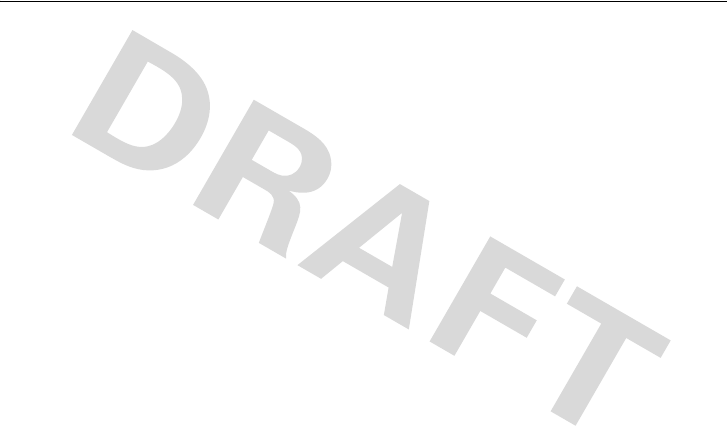
98
WHO Information
Information from the World Health Organization
WHO Info rmation
Present scientific information does not indicate the need for any
special precautions for the use of mobile phones. If you are
concerned, you may want to limit your own or your children’s RF
exposure by limiting the length of calls or by using handsfree
devices to keep mobile phones away from your head and body.
Source: WHO Fact Sheet 193
Further information:
http://www.who.int./peh-emf

Microsoft License
99
Microsoft End User License Agreement
Microsoft License
You have acquired a device ("DEVICE") that includes software
licensed by Motorola, Inc. ("Motorola") from one or more
third-party licensors ("Licensor"), for use in connection with
wireless network services provided under separate agreement
between you and a wireless telecommunications provider ("Mobile
Operator"). Those installed software products provided by Licensor,
as well as associated media, printed materials, and "online" or
electronic documentation ("SOFTWARE") are protected by
international intellectual property laws and treaties. SOFTWARE
includes software already installed on the DEVICE ("DEVICE
Software") and Licensor software contained on any CD-ROM disk
accompanying the DEVICE ("Desktop Software").
The SOFTWARE is licensed, not sold. All rights reserved.
IF YOU DO NOT AGREE TO THIS END USER LICENSE AGREEMENT
("EULA"), DO NOT USE THE DEVICE OR COPY THE SOFTWARE.
INSTEAD, PROMPTLY CONTACT MOTOROLA FOR INSTRUCTIONS
ON RETURN OF THE UNUSED DEVICE(S) FOR A REFUND. ANY USE
OF THE SOFTWARE, INCLUDING BUT NOT LIMITED TO USE ON
THE DEVICE, WILL CONSTITUTE YOUR AGREEMENT TO THIS EULA
(OR RATIFICATION OF ANY PREVIOUS CONSENT).
1. GRANT OF SOFTWARE LICENSE. This EULA grants you the
following license:
1.1. DEVICE Software. You may use the DEVICE Software as
installed on the DEVICE (including as installed on removable media
installed in the DEVICE). All or certain portions of the DEVICE
Software may be inoperable if a proper account is not established
or maintained with an appropriate Mobile Operator, or if the
Mobile Operator's network facilities are not operating or
configured to operate with the DEVICE software.
1.2. Desktop Software. If Desktop Software is included with your
DEVICE, you may install and use the Desktop Software on one (1)
or more computers to exchange information with one (1) or more
computing devices that contain a compatible version of the DEVICE
Software. For other software component(s) contained in the
Desktop Software, you may install and use such components only
in accordance with the terms of the printed or online end user
license agreement(s) provided with such component(s). In the
absence of an end user license agreement for particular
component(s) of the Desktop Software, you may install and use
only one (1) copy of such component(s) on the DEVICE or a single
computer with which you use the DEVICE.
1.3. Back-up Copy. If Motorola has not included a back-up copy of
the DEVICE Software with the DEVICE, you may make a single
back-up copy of the DEVICE Software. You may use the back-up
copy solely for archival purposes.

100
Microsoft License
1.4. Microsoft Windows® 2003. If Microsoft Outlook® 2002 is
included with your Device, the following terms apply to your use of
Microsoft Outlook® 2002: (i) regardless of the information
contained in "Software Installation and Use" section of the online
EULA you may install one (1) copy of Microsoft Outlook® 2002 on
one (1) computer to use, exchange data, share data, access and
interact with the DEVICE, and (ii) the EULA for Microsoft Outlook®
2002 is between Motorola and the end user - not between the PC
manufacturer and end user.
2. Speech/Handwriting Recognition. If the Software includes
speech and or handwriting recognition component(s), you should
understand that speech and handwriting recognition are inherently
statistical processes; that recognition errors are inherent in the
processes; that it is your responsibility to provide for handling such
errors and to monitor the recognition processes and correct any
errors. Motorola, its affiliates, subsidiaries, or suppliers shall not
be liable for any damages arising out of errors in the speech and
handwriting recognition processes.
3. Limitations on Reverse Engineering, Decompilation and
Disassembly. You may not reverse engineer, decompile, or
disassemble the SOFTWARE, except and only to the extent that
such activity is expressly permitted by applicable law
notwithstanding this limitation.
4. Single DEVICE. The Device Software is licensed with the DEVICE
as a single integrated product. The DEVICE Software may only be
used as part of the DEVICE, notwithstanding any installation of the
DEVICE Software on removable media.
5. Single EULA. The package for the DEVICE may contain multiple
versions of this EULA, such as multiple translations and/or
multiple media versions (e.g., in the user documentation and in the
software). Even if you receive multiple versions of the EULA, you
are licensed to use only one (1) copy of the DEVICE Software.
6. Rental. You may not rent or lease the SOFTWARE.
7. Software Transfer. You may not permanently transfer any of your
rights under this EULA with regard to the DEVICE Software or
Desktop Software, except as permitted by the applicable Mobile
Operator. In the event that the Mobile Operator permits such
transfer, you may permanently transfer all of your rights under this
EULA only as part of a sale or transfer of the DEVICE, provided you
retain no copies, you transfer all of the SOFTWARE (including all
component parts, the media and printed materials, any upgrades
or backup copies, this EULA and, if applicable, the Certificate(s) of
Authenticity), and the recipient agrees to the terms of this EULA. If
the Software is an upgrade, any transfer must include all prior
versions of the SOFTWARE.
8. Termination. Without prejudice to any other rights, Motorola,
Licensor and their affiliates and subsidiaries may terminate this
EULA if you fail to comply with the terms and conditions of this
EULA. In such event, you must destroy all copies of the SOFTWARE
and all of its component parts.
9. Security Updates. The SOFTWARE may include digital rights
management technology. If SOFTWARE does contain digital rights
management technology, content providers are using the digital
rights management technology ("Licensor DRM") contained in the

Microsoft License
101
SOFTWARE to protect the integrity of their content ("Secure
Content") so that their intellectual property, including copyright, in
such content is not misappropriated. Owners of such Secure
Content ("Secure Content Owners") may, from time to time, request
Licensor, or its subsidiaries or affiliates to provide security related
updates to the Licensor DRM components of the SOFTWARE
("Security Updates") that may affect your ability to copy, display
and/or play Secure Content through Licensor software or third
party applications that utilize Licesnor DRM. You therefore agree
that, if you elect to download a license from the Internet which
enables your use of Secure Content, Licensor, its subsidiaries or
affiliates may, in conjunction with such license, also download
onto your DEVICE such Security Updates that a Secure Content
Owner has requested that Licensor, its subsidiaries or affiliates, to
distribute. Licensor, its subsidiaries or affiliates will not retrieve
any personally identifiable information, or any other information,
from your DEVICE by downloading such Security Updates.
10. Consent to Use of Data. You agree that Licensor, its
subsidiaries and affiliates may collect and use technical
information gathered in any manner as part of product support
services related to the SOFTWARE.. Licensor, its subsidiaries and
affiliates may use this information solely to improve their products
or to provide customized services or technologies to you. Licensor,
its affiliates and subsidiaries may disclose this information to
others, but not in a form that personally identifies you.
11. Internet Gaming/Update Features. If the SOFTWARE provides,
and you choose to utilize, the Internet gaming or update features
within the SOFTWARE, it is necessary to use certain computer
system, hardware, and software information to implement the
features. By using these features, you explicitly authorize Licensor,
its subsidiaries and affiliates, and/or their designated agent to use
this information solely to improve their products or to provide
customized services or technologies to you. Licensor, its
subsidiaries and affiliates may disclose this information to others,
but not in a form that personally identifies you.
12. Internet-Based Services Components. The SOFTWARE may
contain components that enable and facilitate the use of certain
Internet-based services. You acknowledge and agree that Licensor,
its affiliates and subsidiaries may automatically check the version
of the SOFTWARE and/or its components that you are utilizing and
my provide upgrades or supplements to the SOFTWARE that may
be automatically downloaded to your Device.
13. Links to Third Party Sites. The SOFTWARE may provide you
with the ability to link to third party sites through the use of the
SOFTWARE. The third party sites are NOT under the control of
Motorola, Licensor, or their affiliates or subsidiaries. Neither
Motorola, Licensor, nor their affiliates or subsidiaries are
responsible for (i) the contents of any third party sites, any links
contained in third sites, or any changes or updates to third party
sites, or (ii) webcasting or any other form of transmission received
from any third party sites. If the SOFTWARE provides links to third
party sites, those links are provided to you only as a convenience,
and the inclusion of any link does not imply an endorsement of the
third party site by Motorola, Licensor, or their affiliates or
subsidiaries.

102
Microsoft License
14. Additional Software/Services. The SOFTWARE may permit
Motorola, Licensor, their affiliates or subsidiaries to provide or
make available to you SOFTWARE updates, supplements, add-on
components, or Internet-based services components of the
SOFTWARE after the date you obtain your initial copy of the
SOFTWARE ("Supplemental Components").
14.1. If Motorola, or its subsidiaries or affiliates, provides or
makes available to you Supplemental Components and no other
EULA terms are provided along with the Supplemental
Components, then the terms of this EULA shall apply.
14.2. If Licensor, or its affiliates or subsidiaries, make available
Supplemental Components, and no other EULA terms are provided,
then the terms of this EULA shall apply, except that the Licensor, or
its affiliates or subsidiaries providing the Supplemental
Component(s) shall be the licensor of the Supplemental
Component(s).
14.3. Motorola, Licensor, and their affiliates and subsidiaries
reserve the right to discontinue any Internet-based services
provided to you or made available to you through the use of the
SOFTWARE.
15. UPGRADES AND RECOVERY MEDIA.
15.1. DEVICE Software. If the DEVICE Software is provided by
Motorola, its subsidiaries or affiliates, separate from the DEVICE
on media such as a ROM chip, CD ROM disk(s) or via web
download or other means, and is labeled "For Upgrade Purposes
Only" or "For Recovery Purposes Only", you may install one copy of
such DEVICE Software on the DEVICE as a replacement copy for
the existing DEVICE Software and use it in accordance with the
Grant of Software License section of this EULA.
15.2. Desktop Software. If any Desktop Software component(s) is
provided by Motorola, its subsidiaries or affiliates, separate from
the DEVICE on CD ROM disk(s) or via web download or other
means, and labeled "For Upgrade Purposes Only" or "For Recovery
Purposes Only", you may (i) install and use one copy of such
component(s) on the computer(s) you use to exchange data with
the DEVICE as a replacement copy for the existing Desktop
Software component(s).
16. COPYRIGHT. All title and intellectual property rights in and to
the SOFTWARE (including but not limited to any images,
photographs, animations, video, audio, music, text and "applets",
incorporated into the SOFTWARE), the accompanying printed
materials, and any copies of the SOFTWARE, are owned by
Motorola, Licensor, and/or their affiliates, subsidiaries, or
suppliers. You may not copy the printed materials accompanying
the SOFTWARE. All title and intellectual property rights in and to
the content which may be accessed through use of the SOFTWARE
is the property of the respective content owner and may be
protected by applicable copyright or other intellectual property
laws and treaties. This EULA grants you no rights to use such
content. All rights not specifically granted under this EULA are
reserved by Motorola, Licensor, their affiliates, subsidiaries, and
suppliers.
17. EXPORT RESTRICTIONS. You acknowledge that SOFTWARE is
subject to U.S. export jurisdiction. You agree to comply with all
applicable international and national laws that apply to the

Microsoft License
103
SOFTWARE, including the U.S. Export Administration Regulations,
as well as end-user, end-use and destination restrictions issued by
U.S. and other governments.
18. PRODUCT SUPPORT. Product support for the SOFTWARE is NOT
provided by Licensor, its parent corporation, or their affiliates or
subsidiaries.
19. NO LIABILITY FOR CERTAIN DAMAGES. EXCEPT AS
PROHIBITED BY LAW, MOTOROLA, LICENSOR, AND THEIR
AFFILIATES AND SUBSIDIARIES, SHALL HAVE NO LIABILITY FOR
ANY INDIRECT, SPECIAL, CONSEQUENTIAL OR INCIDENTAL
DAMAGES ARISING FROM OR IN CONNECTION WITH THE USE
OR PERFORMANCE OF THE SOFTWARE. THIS LIMITATION SHALL
APPLY EVEN IF ANY REMEDY FAILS OF ITS ESSENTIAL PURPOSE.
20. FOR APPLICABLE LIMITED WARRANTIES AND SPECIAL
PROVISIONS PERTAINING TO YOUR PARTICULAR JURISDICTION,
PLEASE REFER TO YOUR WARRANTY BOOKLET INCLUDED WITH
THIS PACKAGE OR PROVIDED WITH THE SOFTWARE PRINTED
MATERIALS.

104
Microsoft License
index
A
accessibility 84
accessories 19, 87
connector port 2, 3
ActiveSync 50
alarms 85
alerts
setting 35
turning off 30, 41, 72
animation 91
answering a call 22, 39
attachments 58
auto-lock, phone 31
automatic e-mail setup 47
B
background 36
backlight 39
battery 20
extending battery life 21, 39, 63
indicator 28
Bluetooth
connection 84, 89
indicator 27
remote 65
wireless 63
bonding (See Bluetooth wireless)
browser 92
disconnecting 92
C
calculator 90
calendar 88, 89
call timers 86

index
105
caller ID 43, 83
calls
answering 22, 39
ending 22
forwarding 81
making 22
camera 73, 75
camera key 2, 3
cancel message 55
car kit 87
center key 2, 3
certificate management 90,
91
codes 31
computer remote 65
conference calls 46
contacts 44, 82
converter 90
copying files 64, 78
currency 90
D
date, setting 39
deleting programs 34
dialed calls 41
dialing phone numbers 22
display 26, 39
downloading
e-mail messages 60
files 78
message objects 59
E
e-mail 47, 57, 58
attachments 58
setup 47, 48
signature 58
emergency number 43
end key 2, 3, 22
ending a call 22
entering
numbers 29
text 28, 29
exchange server 48
F
file manager 33
filter 42
flight mode 33
forwarding calls 59, 81
G
games 92
global access look up 55
H
handsfree 87
speaker 30
headset 87
jack 2, 3
home screen 26, 36, 38
hyperlink phone number 82

106
index
I
Incoming Call message 43
international access code 43
internet sharing 67
ISP 57
L
language 84
linking (See Bluetooth
wireless)
locking phone 31
Low Battery message 28
lowercase 29
M
making calls 22, 82
master reset 86
media player 85, 91
buttons 80
controls 80
memo pad 89
menu key 2, 3
menus
icons 26
indicators 26
shortcuts 45
message indicator 27, 28
messages 47, 57, 58, 59
e-mail 47
reminders 85
text 47
text messages 58
missed calls 42
Missed Calls message 42
mode flight 33
modem 67
multimedia messages 47,
58, 59
music 91
N
navigation key 2, 3
network settings 87
networking 67
notes 89
number. See phone number
numbers 29
numeric entry mode 29
O
object exchange 64
opening programs 18
operator hosted e-mail 47
optional
accessories 19
features 19
over the air (OTA) 49
owner information 86

index
107
P
pairing (See Bluetooth
wireless)
pause button 79
PC Remote 65
personalizing 84
phone numbers 24
photos 73, 91
picture ID 43, 83
pictures 91
playing music 79
playing video 79
power key 2, 3, 22
priority 55
profiles 35
programs, opening 18
R
received calls 41
recent calls 41
redial 42
reminders 85
remote control 65
removing programs 34
replying 59
returning a call 42
ring styles
indicators 27
settings 35
ring tones 91
ringer ID 43, 82
ringer volume 85
roam indicator 27
S
safety information 9
security, locking 31
send key 2, 3, 22
sending & receiving
messages 53
setting up e-mail 47, 48
shortcuts 25, 45
side scroll keys 3
signal strength indicator 28
signature 58
SIM card 19
soft keys 2, 3, 26, 38
sounds 85, 91
speakerphone 87
speed dial 44
start menu 18
customizing 38
storing your number 24
symbol entry mode 29
synchronizing 49
Bluetooth 52
cable 51
with computer 50
T
task manager 33
telephone number. See
phone number

108
index
temperature 90
text 29
entry 28
messages 57, 58, 59
third party applications 40
three way calling 46
thumb wheel 2, 3
time zones 90
time, setting 39
timers 42, 86
tips & tricks 25
TTY calls 81
turning on/off 22
U
unlock code 31
unlocking phone 31
uppercase 29
V
video 91
clip 75
controls 80
voice key 2, 3
voicemail 45
voicemail message indicator
45
volume 30, 85
volume keys 2, 3
W
wallpaper 36
warranty 95
Web 92
browser 91, 92
browser, disconnecting
92
page 91
web
browser 92
page 92
phone number 82
weights & measurements
90
Y
your phone number 24
U.S. patent Re. 34,976